#48 • December 11, 2021–January 30, 2022: Dragon Guts at Lubov, 5 East Broadway, #401 & #402, New York, NY
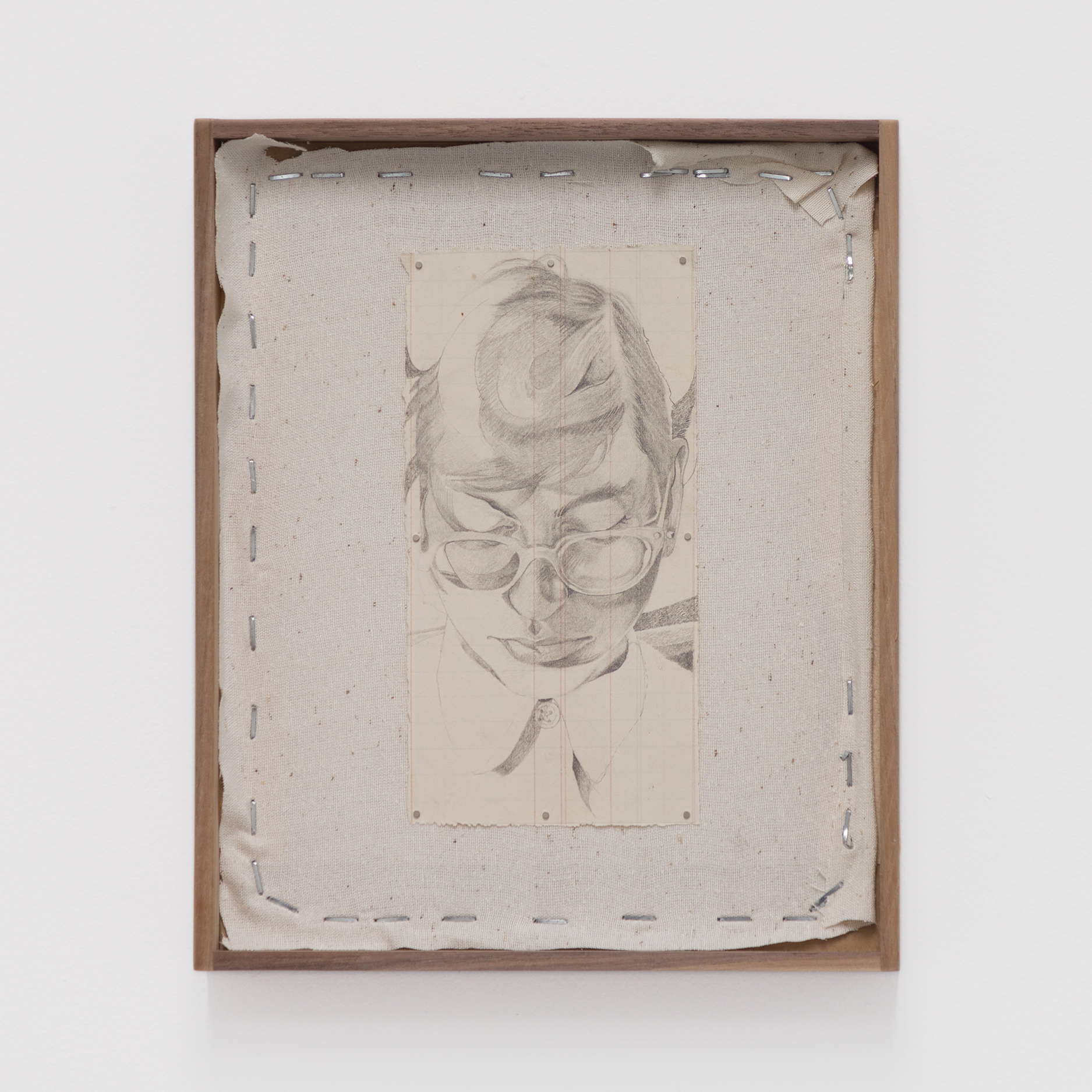
Opening reception: Saturday December 11, 6-9 pm
A body is a strange thing to carry around. It holds the promise of liberation while also serving the carceral gaze of a society married to a binary worldview. It’s the paucity of imagination manifesting demise. A demise that permeates every layer of being intent on forcing classification.
In Jobi Bicos’ world, the monochromatic drawings paradoxically eschew us away from a lackluster world, into one bursting with boundless possibilities. Imagine if you will, waking up and waltzing with your inner demons. A symbiosis of your deepest fears and your wildest fantasies blending with dragons and chimeras roaming a world adjacent to ours. The characters live in a parallel dimension that revels in the bounty of all the things we’re told are impossible. Their physique transcends both language and gender. The fabric of existence is woven by shapes and textures that bear a vague resemblance to things we’ve seen in our earthly realm: teeth, cells, sinuous roads forming labyrinths. The only roadmap to this world is intuition.
Here, Jobi wonders, what if we were made of dreams? What if our consciousness is merely a portal to iterations of ourselves that transcend all earthly limitations? Their drawings contain an unshakable faith in magic that is palpable but just out of reach. Their work asks you to leave the world as you know it behind and plunge into a universe where the laws of physics remain unwritten. You can color these drawings with your mind’s eye however you wish or leave them as they are. Like traditional puzzle pieces, these works in their unassuming size are tools that come together to form an image of a universe devoid of rigid structures and antiquated beliefs. The difference here being, that these drawings nudge us to bring pieces of that world back into the one we inhabit.
So, go on. Look to your left, then to your right. Your compass is your imagination.
—Lara Atallah, December 2021
Jobi Bicos creates paintings and drawings exploring the possibilities of visualization, fantasy, and sensation in conceptions of their body in space. Born in Arcadia, California (1993)—they received their BFA from the San Francisco Art Institute (2014) and MFA at the Milton Avery Graduate School of the Arts at Bard (2020). Their work has been included in group exhibitions at 1038, 100%, Altman Siegel, Ratio 3, and Et al etc. in San Francisco; and Nicelle Beauchene Gallery in New York. They live and work in Los Angeles.
With gratitude to Jordan Barse.
https://lubov.nyc/jobi-bicos-dragon-guts
Image: ©Jobi Bicos, Portrait, 2021. Pencil on found antique paper in artist frame.
#47 • September 18, 2021–November 7, 2021: The Loo Table at Lubov, 5 East Broadway, #401 & #402, New York, NY
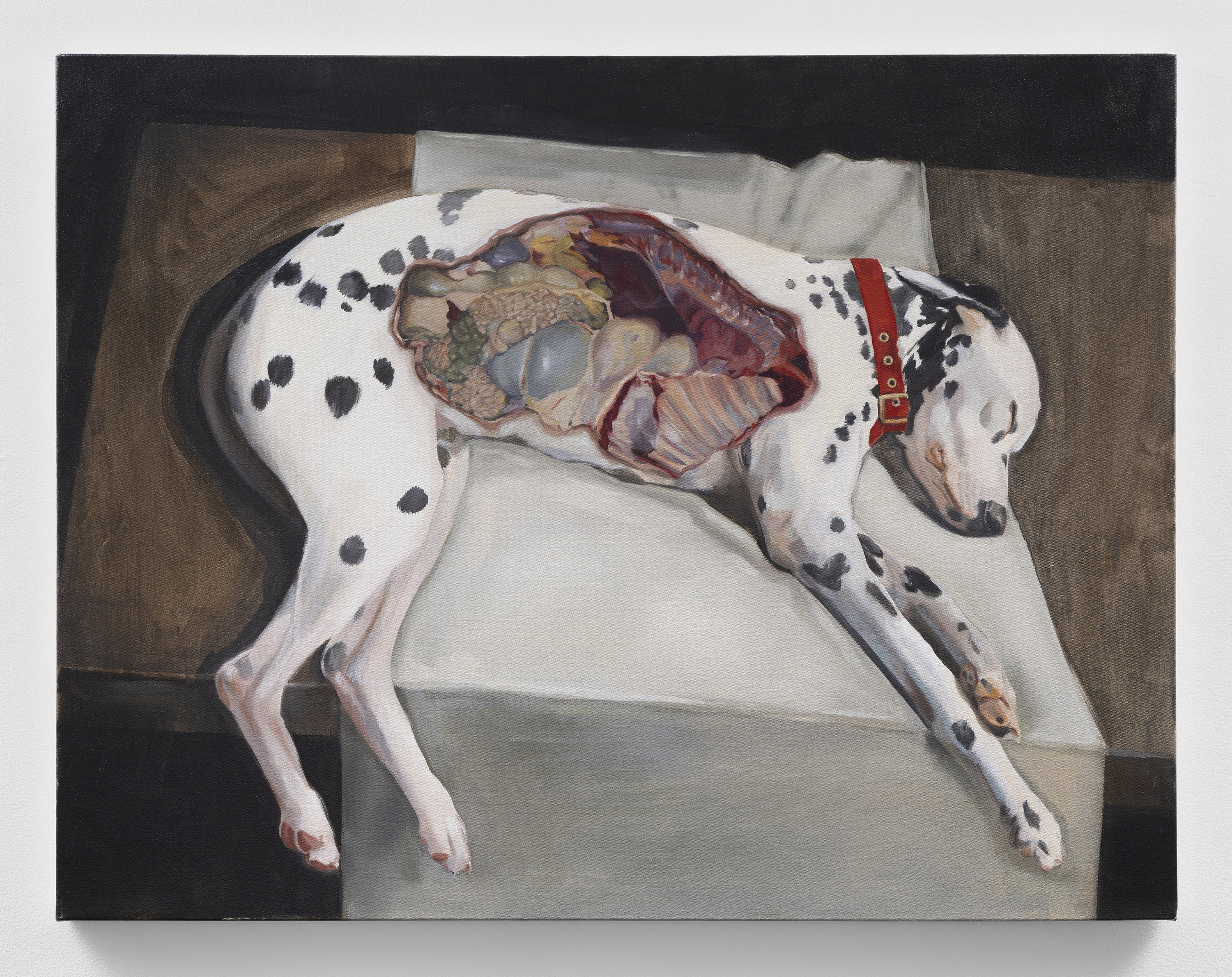
Opening reception: Saturday September 18, 6-8 pm
If you touch the brass mechanism fitted at the base of a loo table, it will fold to make itself small and storable. It’s the effort of the game that makes for a small gathering. Many hands held small cards for the trick-taking game with the cute name; Lanterloo. Wrists would bend to match the wood grain that turns at the edge of an oval. Loo: a word that lifts the tongue to the roof of the mouth and rolls off and onto a surface. Loo is the loser, the runaway, a lullaby, and a 17th-century card game. Loo is as darling as the stomach of a dog. A pallet of gray browns and murky pinks that muddle with precision. It may be as clear - as - day or as sweet as the sweet spot.
Shannon Cartier Lucy’s paintings furnish a world of cutthroat silks and satins, a perfect union of macabre divinity, where pain, pleasure, self-sabotage, and self-preservation elide. The scenes arrive as passive visions and cerebral souvenirs, all shrouded in her past and present. They animate through nuance, small gestures, or blanket statements. You are describing the thing, but it will work against and around you. They are willful masters of escape. If you are waiting for the moment when the painting becomes pathological, don’t.
The gap between feel-good and foul play is at times so narrow that extracting one from the other becomes an arduous task. This lack of resolve marks the space between the viewer and the work, where attention shifts towards minor and interstitial moments of bliss, blur, and incongruence, like a moth to a flame. Tactfully sweet and unapologetically honest, Cartier Lucy images are as specific as they are untraceable. You are edging towards a reason, but the dead-end wins. Maybe it's just part of the game to feel forlorn or ecstatic by proxy of an image. If her paintings aren’t mirrored walls or wet dreams, then what can they do? Perhaps taking the high road is a matter of naming binaries: bizarre and ordinary, intimate and distanced, intriguing yet uncomfortable, comedic yet disturbed. There is space for endless narrative possibility, speculative fantasy, and choking on the hand that feeds you.
This kind of facility makes not only for a tight-knit canvas but captures what is both dear and perverse on the same plane; a union of perfect discord, with everywhere to run and nowhere to hide. Things familiar and kinky buoy to the surface because they can. What ties itself to the experience of her work is bittersweet and unforgiving. Shannon Cartier Lucy gives way to a hypnotic world founded on taboo and ambiguity, where psychic undertones are padded in sucrose and relentless in their grace.
—Claire Sammut, September 2021
Lubov is pleased to present The Loo Table — painter Shannon Cartier Lucy’s second solo exhibition at the gallery, following her New York solo debut in January 2020. Drawing together nine oil on canvas paintings, the exhibition includes seven new works Cartier Lucy has created specifically for the show, presented alongside two paintings from 2018 that have never before been exhibited publicly. On occasion of the exhibition, Hassla Books is publishing Cartier Lucy’s first monograph, titled Better Call it Grace. Created through a close collaboration among Cartier Lucy and Lubov, New York, Galerie Hussenot, Paris, Massimo de Carlo, Milan, Night Gallery, Los Angeles, and Soft Opening, London, the publication unites images of all the artist’s paintings from 2018 to 2021, along with essays contributed by independent curator Claire Sammut and writer and artist Adam Lehrer.
https://lubov.nyc/shannon-cartier-lucy-the-loo-table
Image: ©Shannon Cartier Lucy, The Autopsy, 2021. Oil on canvas.
#46 • August 7, 2021–September 12, 2021: Bushman's Poetry, Starman's Prank at Lubov, 5 East Broadway, #401 & #402, New York, NY
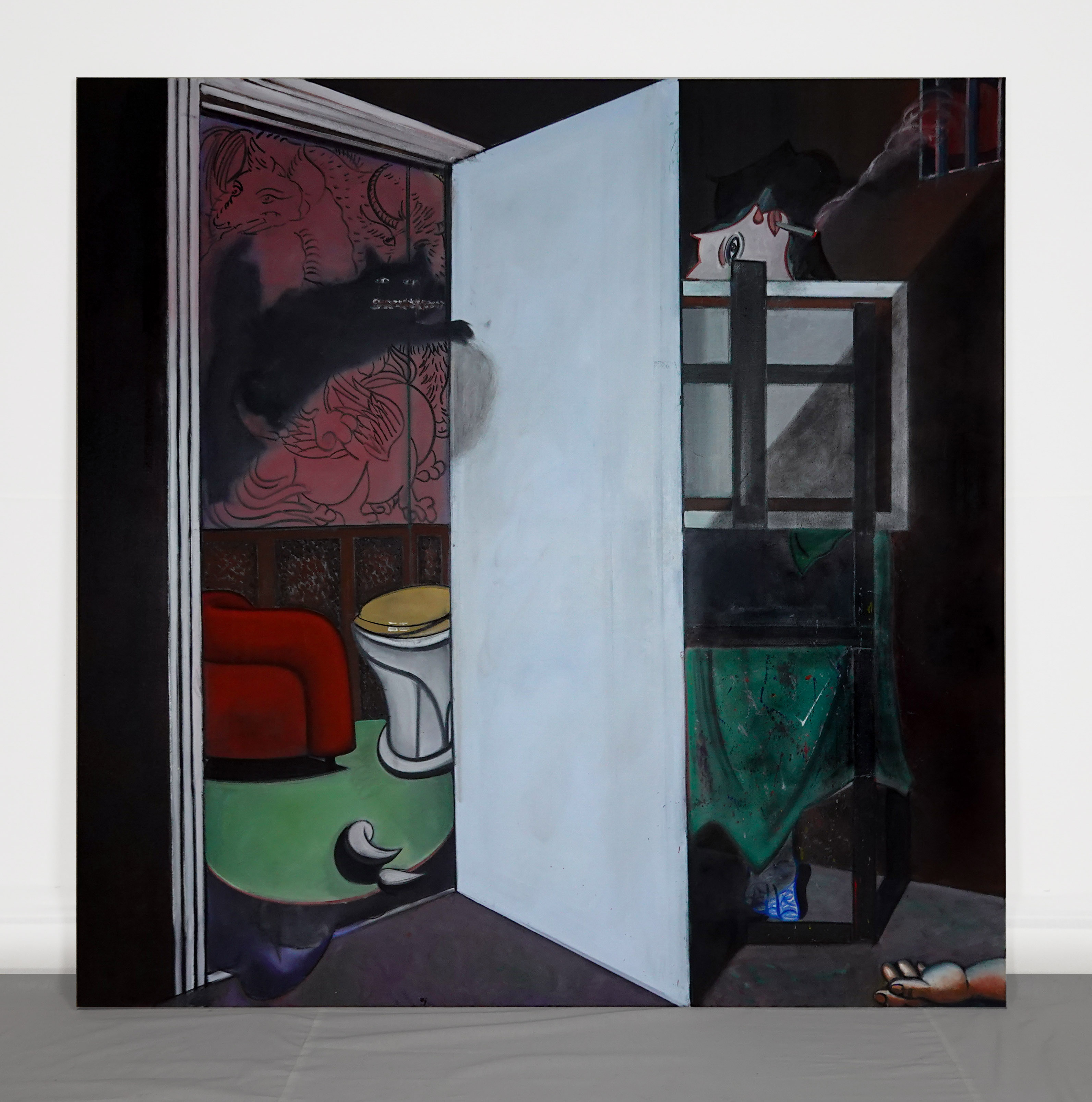
Opening reception: Saturday August 7, 6-9 pm
A definitive Hwi Hahm style does not exist — at least not yet. That is because his paintings are not invested in a continuum, they are all about the feel, the excitement, the going-for-it-ness of putting brush to canvas. These are paintings he simply has to paint, interested as he is first and foremost in an image’s mystique, the power and pull they have over him. When a picture shows up in his life and demands to be painted, when it tugs at his brain and at his dexterous brush-holding fingers, who is he to turn it away, to deny its wishes? There are simply too many compelling images, too many seductive elements and objects in the world, and too short an artistic life to be too fastidious about it. The images in his mind are fickle and exacting, once he has set them down, realized in his visual world, most of them will leave him alone, which is why you won’t find a preparatory sketch or an essay for any of his paintings. Once an image has insisted its way into a gouache on paper or an oil on canvas, its job is done and the elation of its creation promptly wears off. The bits and forms that do return, that find a way of haunting Hahm and sticking around, become intriguing clues: Forsythia in Forte! Celebrate, Celebrate, Celebrate! (Forthysia Girl and the Hunter) (2021) has a white and pointy face that comes back as a part swordfish, part octopus creature in the delightfully disorienting Catch Me (2021); so does the hunter that accompanies her to the fire, he is around again in Seven Hunters by the Fire (2021); and so are the creeping, glowing vines that climb on Forthysia’s leg in the forest, and which later populate the psychedelic landscape in A Beautiful Day in the Neighborhood (2021). But it is not these motifs that ultimately institute Hahm’s practice, his impetus is seeking the feels and thrills of the very action of painting an image. Everything else is in service of those moments and they become themselves permission for drastic stylistic adventurousness: Lines go from thick and cartoony to smooth and ethereal, tridimensional perspective melts into flatness, as does the binaries of inside and outside, the near and the far, the figurative and the abstract. Hahm is equally compelled by the pictorial possibilities of mythological storytelling, as he is by the random beauty of urban splatter on his neighborhood’s asphalt, or by the metaphysical depth of the color blue. The world concocted by Hahm’s paintings is one of pleasurable jolts, puzzling dislocations and representational bewilderment. A brewing, gripping mystery.
—Gaby Cepeda, July 2021
https://lubov.nyc/hwi-hahm-bushmans-poetry-starmans-prank
Image: ©Hwi Hahm, Metamorphosis, 2020. Oil on canvas. 72 x 72 inches
#45 • July 2, 2021–August 1, 2021: Disease Was My Life Coach at Lubov, 5 East Broadway, #401 & #402, New York, NY
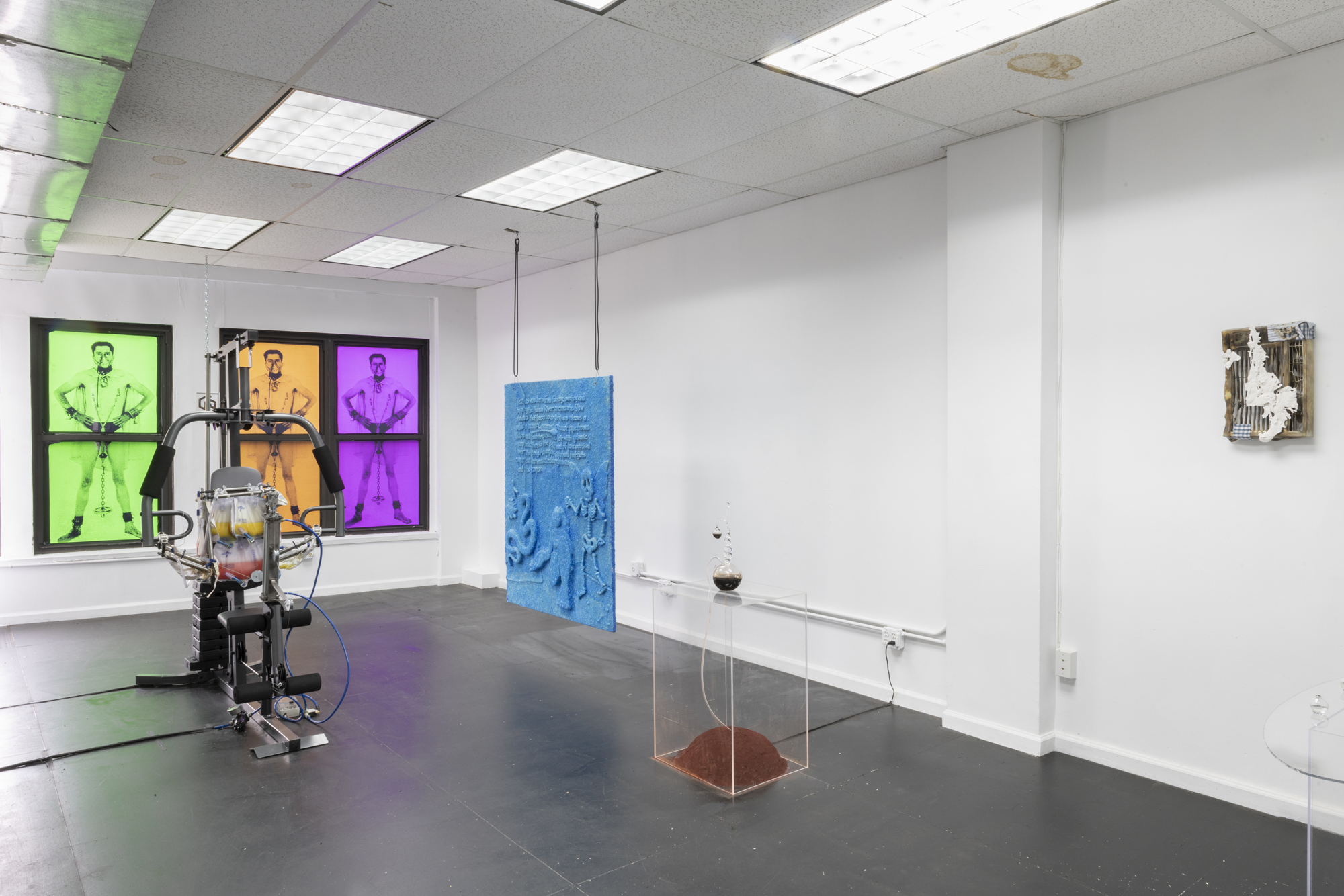
Opening reception: Friday July 2, 6-9 pm
Curated by Jacques Louis Vidal
It should be useful that I find myself, the weekend before this show opens, lying down in a cold sweat feeling deeply nauseous, the victim of some kind of bacterial attack likely caused by insisting on cleaning up a huge pile of garbage my neighbor left out, which caught on fire revealing and melting all of its contents. I love cleaning up trash, and it finally came back to bite me. Still gotta write this damn thing.
Whats most clear in this horizontal place, however, is that extracting anything from this immobilizing feeling of ailment is nearly impossible. It is this way with the physical reality inside the body when a violent state change occurs. There is always great difficulty in interpreting the present. It can’t be made metaphor, it can only be literal so not fully describable... at least not for right now.
So I attempt to enjoy my symptoms, and cultivate a logic around making them useful towards feeling control of the next moment. This need for control, yet another pathology :(
In making art and speaking with other artists about their work I will often trust the conversations most that tend towards the physical condition of the making of the work. This can take many forms: a discussion about the identity of the body making the work – and its material conditions, an idea about what one is physically attracted/repelled by, a skill and deskill dynamic of what someBody is and isn’t capable of doing, and perhaps most important the physical transformative power of creativity, in its ability to invert a destructive force into a constructive one, or even just from red to blue.
The work I chose for this show in collaboration with Lubov speaks to a spirit of strength, and power of artists. I reject the suggestion that artists must be resilient, must make do, or must compete with one another for anything. I propose that this work hover in this realm above this one maybe even a realm closer to death than life, in a state which cannot be instrumentalized.
—Jacques Louis Vidal, June 2021
https://lubov.nyc/disease-was-my-life-coach
Image: installation view of Disease Was My Life Coach at Lubov.
#44 • April 14, 2021–June 13, 2021: Delayed Green at Lubov, 5 East Broadway, #401 & #402, New York, NY
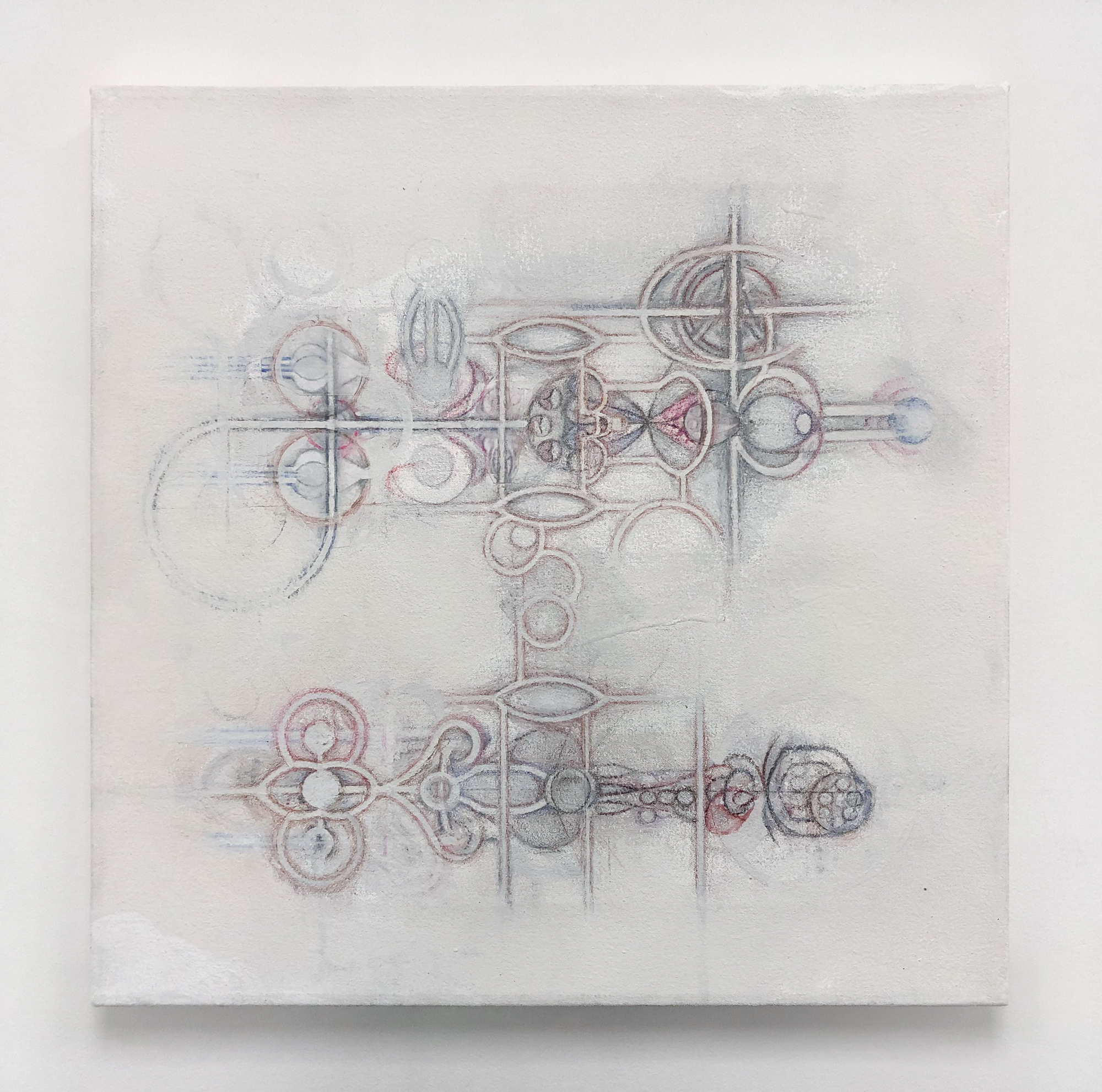
Opening reception: Saturday April 24, 4-8 pm
Next involuntary chapter, down to infinity
I’m whittled down / Something moved by non-stop travel / A centimeter out of reach, / Slouching
Chemtrail lattice / Seen from a bus
Give me a sign / Mends the damage
Mutable expert / Habits hold the reigns / To be born
Invisible apple / I want a way
—Daffy Scanlan and Chiara Ibrah, April 2021
https://lubov.nyc/delayed-green
Image: ©Daffy Scanlan, Moving Answer, 2021. 20 x 20 inches.
#43 • February 20, 2021–April 11, 2021: All by Myself at Lubov, 5 East Broadway, #401 & #402, New York, NY

Opening reception: Saturday February 20, 4-8 pm
Are they sepulchurs? Are they doors? Are they bats? Are they self-portraits? Are they apotropaic talismans, to ward off despots? Do they glow? Does their marsupial shine brighten your mood or dampen it? Can you bite their surfaces? Do you wish to be bitten? Is your mouth protected from invaders? Do you live by yourself? Will you marry me? Where is my twin? I lost him or her or them in the shopping mall. We were browsing in the lab-equipment aisle. Is Clorox shelved near the Philip Guston books? Why do I hide my Judy Garland Alone album? I starred in Carmen at the climax of puberty. I threw my "Habanera" rose, like a bride’s garter, into the audience. I leaked solitude, like dribble out a slack mouth, a “hag-born” (quoth Shakespeare) daysleeper, fuschia-faced. I met Kev when he was very young. He wore a complicated shirt, with at least two layers, asymmetrical. The only time I saw a bat upclose was when I removed the air conditioner from a bedroom window and discovered a sleeping vampire nestled between the windowsill and the appliance's bottom. Underneath the top layer of Kev's paintings, hieroglyphic inscriptions, like spit-out bones, vibrate. I’m staring into the painting’s pond to see bodies buried beneath its algae scrim. Perhaps Kev’s words, what Kev might tell you in his dreams, are hidden behind the painting’s uppermost skin. Kev and I had several long conversations about the painter Miriam Cahn; we support, Kev and I, a culture of blur, of figures subjected to the healing agency of distortion and miasma. We may not wish to see or say things clearly. In quarantine we are sometimes lonely but often entranced by pigment sticks—an efficacious way of smearing color boldly in medias res onto the rising action. Willem de Kooning as a young man looked like a friend of a young Marlon Brando. There is almost no connection, in the scrupulous scholar’s mind, between the painter and the painting; the painting has its own biography, immune to the insinuations—the slander—of the painter’s own story. Isn’t that a bat’s prerogative—to be vaccinated against biography? To be free from the implicating terror of psychoanalytic cause-and-effect, teleology, aetiology? Wrong. Psychoanalysis—Kev knows and feels this fact, I suspect—goes backward, a reverse logic. Tomorrow causes today. Kev Tobin causes Willem de Kooning. Tomorrow’s pulsar causes yesterday’s primal scene. We don’t dwell in conspiracy theories. We believe in science. Imagine how deplorable the world has become, that we need to defend science’s right to know, to investigate, to assert. These paintings, Kev’s first solo show, have a say in making this world less deplorable, for those viewers fortunate enough to stumble upon these doors, these portraits, these emblems, aglow with the artist’s promise and with his generous, if solitary, wish to make your inner surfaces (your dreams, your mucous membranes, your emergencies) shine with the same numinous intensity as these demonstrations, which means monster and also means love, a bat’s wing loving its other wing, the pigment stick loving the layer of paint it lands upon with a familial pressure, a sibling weight. The extinction of species and the application of paint may have nothing to do with each other but I believe that Kev’s paintings are brooding about extinction and the daily movement against it, the labor, slow and principled, of taking a stand against unnecessary destruction. The art we make knows about the catastrophes we only half-acknowledge in our waking language. The virtue of Kev’s impeccable paintings is that they traffic almost entirely in the pulsations we are afraid to acknowledge.
—Wayne Koestenbaum, February 2021
https://lubov.nyc/kevin-tobin-all-by-myself
Image: ©Kevin Tobin, White Bat, 2021. 84 x 28 inches.
#42 • December 10, 2020–February 7, 2021: Solace at Lubov, 5 East Broadway, #401 & #402, New York, NY

Opening reception: Thursday December 10, 4-8 pm
Think of Solace as a hyper-compressed Marsha Pels retrospective: two imposing sculptures, made thirty years apart. Both Pieta (1988) and the never before shown Fallout Necklace (2018) are exemplary meditations on the artist’s chosen materials and process, and both examinations of the vicissitudes of power. Both ask us to consider from whom we expect compassion, and who inevitably fails to deliver.
Over the course of four decades, Pels’ sculpture practice has drawn both from her autobiography and deep historical research, treating subjects such as gender identity, war and power, and contemporary politics. With an inventive and improvisational spirit, Pels has mastered intensive processes such as metal casting and fabrication, glass flameworking, and photoetching, as well as transformations of found objects. In short, anything—from broccoli to boots—is a plausible raw material, alchemized and concretized evocatively by her hand. Such transubstantiation infuses her sculpture with a remarkable psychological intensity and metaphorical strength.
In cast bronze and cast crystal, Pieta—Italian for “pity”—subverts the religious art icon of the Virgin Mary cradling the dead body of Jesus. Pels’s version deconstructs the myth of exalted motherhood: this mother is disembodied, contoured only by her leather fetish gear and a gas mask, cast in bronze, and just barely holding, away from her body, her fragile cast crystal baby. While the precise narrative remains ambiguous, Pieta figures a confrontational maternal ambivalence, the picture of a woman at war—with her own body, with the world controlling her body, with her child’s suffering powerlessness and her own. We may resent her lack of compassion, but recognize she is also in need of it.
Fallout Necklace contains a similarly jarring juxtaposition: along an outsized, ornately beautiful necklace (perhaps a tiara?) are powder-printed glass images of eight world leaders representing the global political superstructure. In clockwise order, Donald Trump, Vladimir Putin, Xi Jinping, Theresa May, Emmanuel Macron, Bashar al-Assad, Angela Merkel, and Kim Jong-un look out towards us or sideways at one another, among sinewy symmetric patterns of cast steel and aluminum, studded with colored glass gems. Pels’s contemporary critique is embedded within a simultaneous reference to and recreation of the 19th-century European style of “Cut-Steel and Berlin Iron” jewelry, known for its detailed and masterful metalworking in steel and cast iron. It came to prominence in France and Germany when royals enlisted aristocratic women to part with their precious gems in support of national war efforts. How many suffer today from leadership’s frightening omnipotence to hoard and consolidate wealth and power in the name of nationalism? Pels’s necklace, the trophy of abuse, embodies the insidious, interconnected architecture of nation- and world-making—its elaborate, pitiless beauty belying the inevitable fallout.
—Sara Softness, December 2020
https://lubov.nyc/marsha-pels-solace
Image: ©Marsha Pels, Fallout Necklace, 2018. From the series Trophies of Abuse. Patined cast aluminum, patined steel, flame-worked glass, powder printed glass. 84 x 120 x 180 inches. Installation view at Lubov, New York, 2020.
#41 • September 27–November 22, 2020: Afternoons at Lubov, 5 East Broadway, #402, New York, NY
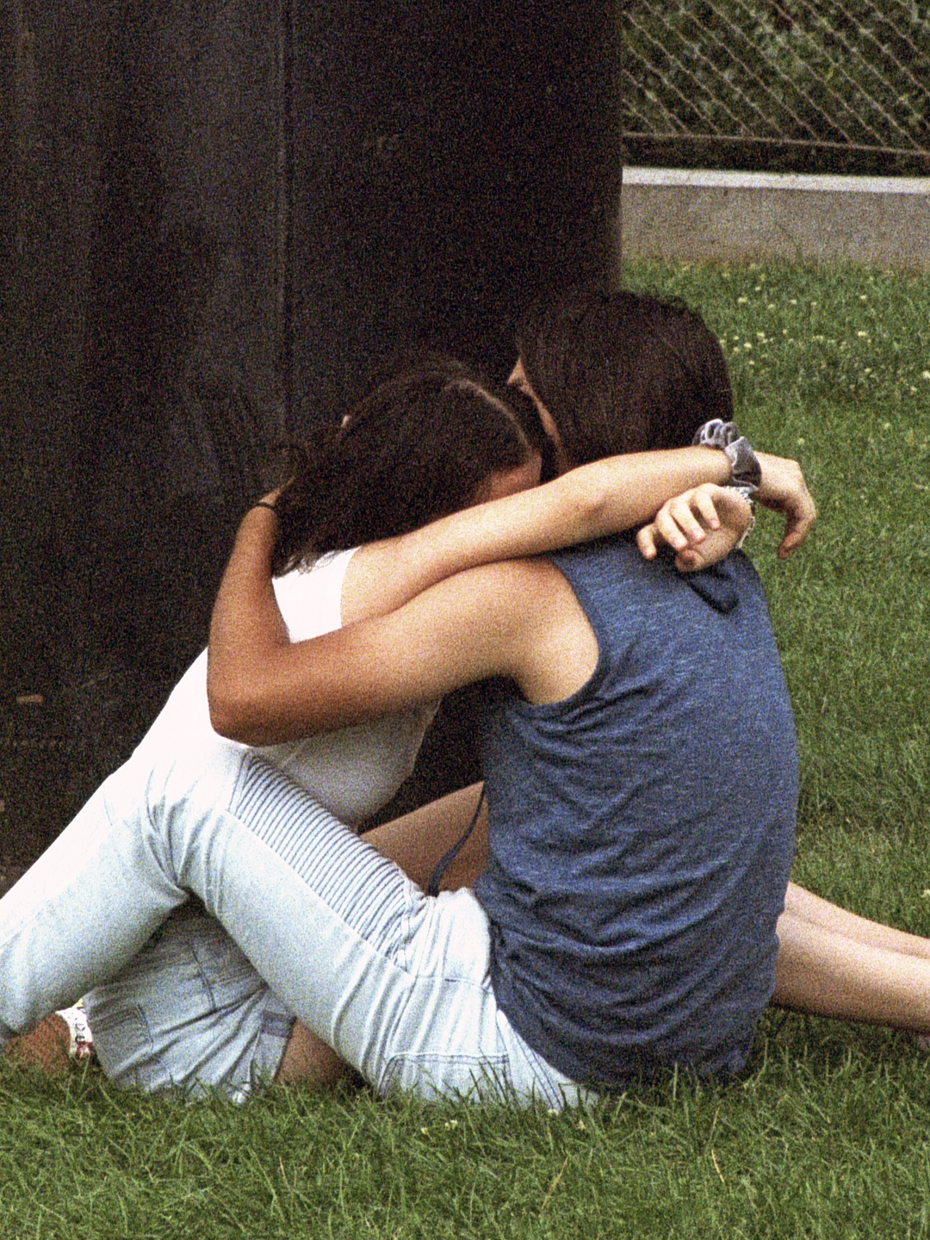
Opening reception: Sunday September 27, 12-8 pm
Between shoots, Jenna Westra writes down lists of directions she would like to explore with the models she photographs using an analog camera in her studio. They are bits of texts, vignettes, simple ideas for settings and movements, different ways that different bodies can meet and interact. Westra’s models are often dancers, who, she explains, have a good understanding of their body and how their body moves, who are comfortable being in front of the camera, who are always moving and trying things even if they are not being directed.
The pieces of descriptive texts thus meet the models’ will and movement, choreography meets chance and accident, the process leaves room for gaps between words (a woman leaning back while a hand is dangling a feather above her head) and image (the black-and-white tones are so soft, the white fabric draped over a pedestal she leans on is rendered on film as a subtle gray, as is the wall, as is her skin, but the black of her long-sleeved turtleneck is rich and fills the frame. Her eyes are open, focused on the feather). Those gaps are not in details, but in tension, the feeling that something is off, or left out of the frame, that action is decisive. The result feels casual, often spontaneous: these are women being creative, interacting, touching, feeling comfortable with one another.
The photographs document these moments of encounter, and create a space for women to inhabit that feels free, youthful, and feminine. Gendered, but not overtly sexual, and conscious of being seen, still free from specific kinds of sight. Dancers (Backbend), 2020, shows the bodies of two women encased. One woman bends forward and the other, facing the opposite way, leans back so that her back aligns against the other’s. They both wear leotards in shades of nude so close to their skin that they are almost nonexistent and the curves and contours of their bodies perfectly match, nesting one body in the other. The lack of detail in the photographs often taken indoors and against neutral backgrounds, with a prop or two, and very few other signifiers, makes what is feel momentous: the smallest things—a tan line, a lock of dark hair, an armpit—join the gesture in the creation of a scene that feels endlessly intimate.
Six of the seven photographs in the exhibition were taken in the studio, with one outdoor picture, of lovers in a park, shot from afar with a long lens. The materiality of analogue photography, which defines Westra’s work, is here palpable because of the grain that results from cropping and enlarging 800 ISO film in the color photo. There is no information about the couple: the photo documents a man, his back to the camera and his arms around the woman in front of him, whose hands are crossed behind his neck. A small scrunchie around the woman’s wrist feels like a detail so specific to her, as if it becomes a stand-in for any kind of knowledge about her, for all narrative about them. What Westra stages elsewhere in her photographs—intimacy, familiarity, touch—is found by chance here, in afternoons.
—Orit Gat, March 2020
https://lubov.nyc/jenna-westra-afternoons
Image: ©Jenna Westra, Park Picture (Les Fleurs), 2020. Archival pigment print. 20 x 16 inches.
#40 • August 29, 2020: Rainbows End at Love, 1461 Broadway, Brooklyn, NY

Opening reception: Sunday August 29, 6-8pm
Curated by Francisco Correa Cordero
Seth Cohen, Nathan Gwynne, Alexis L.-Grise, Shori Sims, Dorothy Zhang.
https://loveclub.tv/rainbows-end
Image: ©Dorothy Zhang
#39 • March 14–April 26, 2020: Lines from Arguments at Lubov, 5 East Broadway, #402, New York, NY
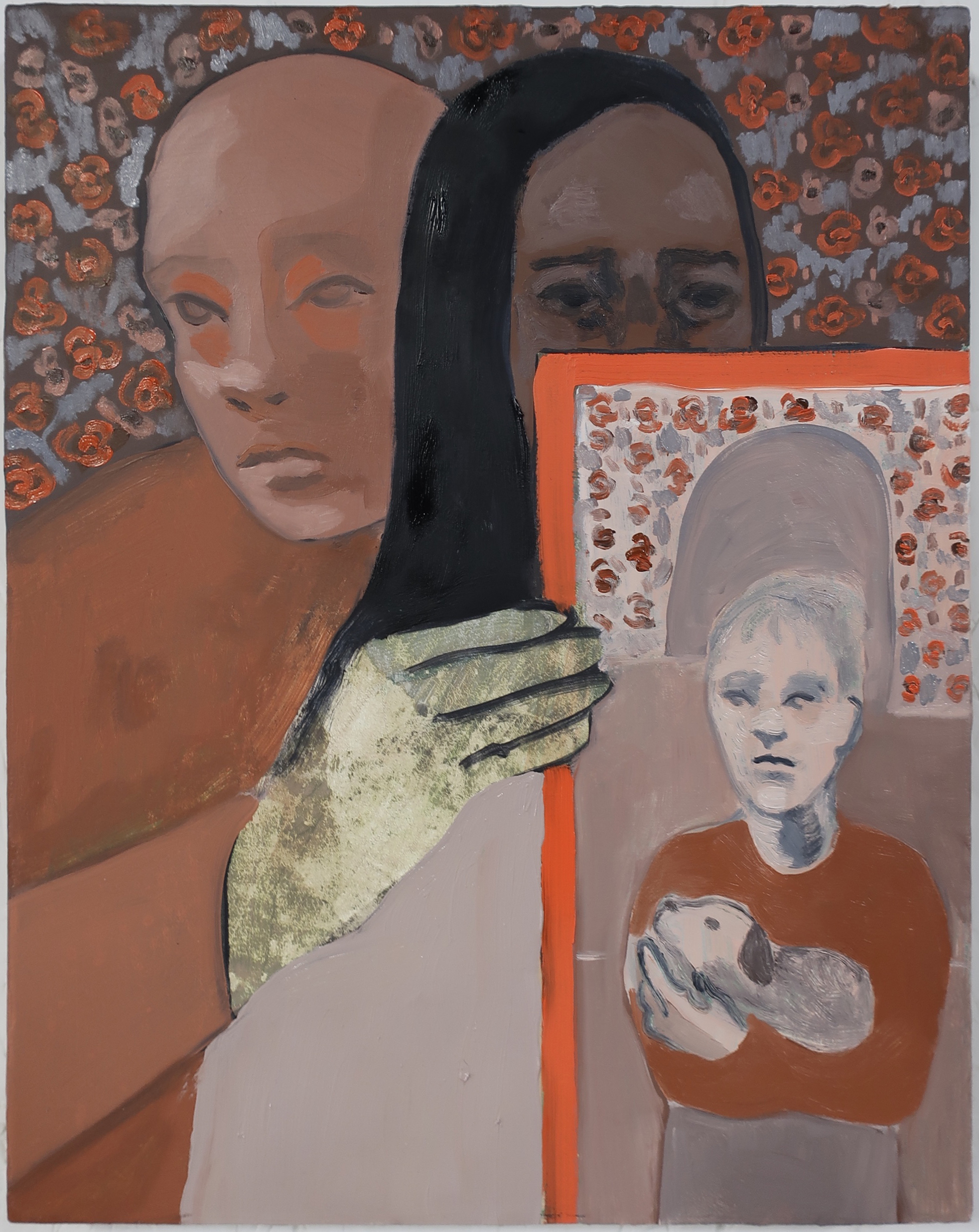
Opening reception: Saturday March 14, 6-8 pm
Depthless theatrical spaces in color palettes of decomposing fruits set the stage for alienation and co-dependency to unfold between Katja Farin’s easily relatable subjects. In bright but unsettling mise en scènes, catatonic characters rely on frozen gesture to disclose their nuanced interpersonal relationships. This muted desperation for communication reinforces proximity and socialization as basic needs for survival. The aphasic actors also interact with carefully selected props. Ropes and nets dually function as boundaries and tethers; space akin to a two-way mirror creates inverted portals to internal space or reflects distant figures from somewhere “offstage”.
In this suite of new paintings, Farin further explores the closed-circuit dynamics of couples, specifically, the moment communication is strained, manipulated, and weaponized in a fight. Derived from a single line plucked from an argument, the paintings illustrate when tensions between a pair reach a fever-pitch and condense around attitudes. The scenes are snapshots of an unknowable histories offered up to be filled with one’s own history.
Although often working from staged scenes in the studio with friends as models, Farin’s nondescript facial features and indifferent expressions fashion subjects as mirrors or vessels equip with ample space to hold the psyche of the viewer. The subjects’ uniform demeanor, expressions, and features echo the notion that every interpersonal interaction contains a projection of the self. By granting a removed perspective, Farin exposes just how interchangeable and common our experiences are, yet any conception of a collective unconscious still must be localized in individual bodies.
—Marie Heilich, March 2020
https://lubov.nyc/katja-farin-lines-from-arguments
Image: ©Katja Farin
#38 • January 18–March 8, 2020: Home is a crossword puzzle I can’t solve at Lubov, 5 East Broadway, #402, New York, NY

Opening reception: Saturday January 18, 6-8 pm
Shannon Cartier Lucy’s paintings are loquacious despite seeming unassuming. They thrust you towards the edge of a precipice right where your inhibitions end and your subconscious begins. Suddenly, you find yourself in the entrails of a complex labyrinth where the walls are moving, reconfiguring the very space you’re walking through. Each painting is a clue in a grander narrative arc, but there is neither a linear sequence to the story, nor is there a plot. Only a feeling of uprootedness. Are you looking inside someone else’s mind or your own?
The scene is set in the moments preceding your awaking. You are knee-deep in a lucid dream. Your subconscious is soliloquizing. The hushed tones and the mostly desaturated color palette render the surroundings slightly lugubrious. You have the power to wake up, but you opt to stay in this parallel universe.
In the kitchen, goldfish are swimming in their bowl on an open stove flame, but the water has yet to boil. A woman sleeps under a large plastic wrap covering most of the objects in the room. You can’t see enough of her face to ID her. Does it even matter? Another woman —or maybe it’s the same one— is carrying swans in a plastic bag as though idly coming back from an errand run. Elsewhere, books scattered pell-mell on a library floor between two fully stacked shelves form a colorful pathway to closed doors. Another woman is lounging on a couch absorbed by her copy of Sex After Death.
The work exists in a liminal space toeing the line between eerie and hilarious. Lucy is summoning the subconscious mind to the forefront. In doing so, she reconfigures the world into an unsolvable Rubik’s cube.
—Lara Atallah, January 2020
https://lubov.nyc/shannon-cartier-lucy-home-is-a-crossword-puzzle-i-cant-solve
Image: ©Shannon Cartier Lucy, Girl with Swans, 2019. Oil on canvas. 31 x 22 inches.
#37 • November 23–January 5, 2020: Halo in a Hayloft at Lubov, 5 East Broadway, #402, New York, NY

Opening reception: Saturday November 23, 6-9 pm
A friend of mine began riding horses this past spring. For her, it’s part of a larger exploration in power—apparently working with horses is all about power. The quiet kind. Like communicating with the flexing of your thigh, and the unspoken force woven between both your bodies. The horse can sense your mood as you near it; your approach is everything. The horse will not budge without some trust; you have to partake in a dance between the lines of equality and dominance, respect and control.
I began eating meat for the first time in my life because I felt powerless. Consuming meat felt like a literal answer to depletion (both physical and emotional). I don’t always feel comfortable with eating animals; I often experience more disgust and shame than pleasure—but it’s become this symbolic choice. I’m sick of feeling like prey, and I’ll consume some blood to understand that feeling a bit better. One way of looking at eating animals, someone told me, is that you are consuming the animal’s properties when you eat it. So, eat a cow, and become more cow. It’s simple and kind of beautiful.
To cook steak, I learned a trick to tell how well-done it’s become. You must press on the soft fleshy part of your inner-thumb and compare its consistency to the cooking fillet. This is the kind of meat-eating I love—when my body and the cow body are cooked to the same touch.
In Noel’s drawings and sculptures of animal effigies, I feel distant enough to understand modes of attachment, and the way we sometimes perform two contradictory things at once. Like the line between brutality and tenderness. How can a certain type of touch be careful and caustic at the same time? What about the kind of touch that is repetitive, becomes ingrained to your body’s rhythm, but then goes missing–so it’s absence is all the more present? Like a body after a breakup. Or the halos we reserve for the things we can not have.
A dog licked my ear the other day, and I thought about a past boyfriend. It was weird.
“Witchcraft capacity may also be acquired in innocence if one should unsuspectingly eat meat that is in fact human flesh. The fatal meat may be consumed ‘at night’ that is, in one’s dreams, but it’s nonetheless binding” Is this what I am after—a type of magic? Not necessarily a good kind, but the kind that can bind me closer to whatever beast I feel like I cannot defeat. I wanted to change, so I started eating meat. Perhaps I wanted to consume a much more fatal kind of meat, consumption of human flesh–or human emotion. Bring me closer to feeling with these times, digest the political, finding where the personal and the symbolic can lead me to its gate. I think that’s the kind of meat I’m after.
—Amanda Horowitz, October 2019.
https://lubov.nyc/noel-freibert-halo-in-a-hayloft
Image: ©Noel Freibert, Shepherd, 2019.
#36 • September 28–November 10, 2019: Best Western at Lubov, 5 East Broadway, #402, New York, NY
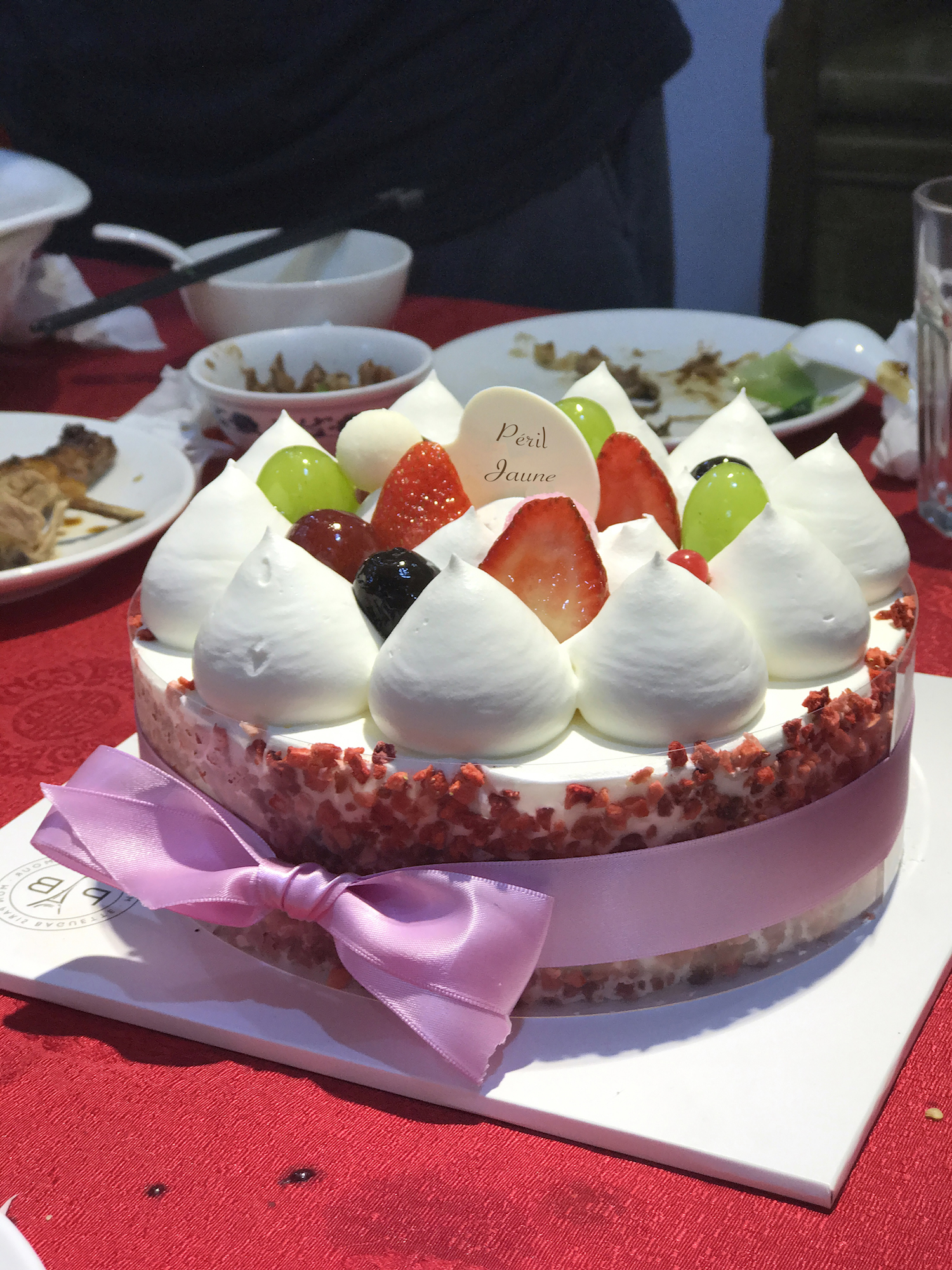
Opening reception: Saturday September 28, 6-9 pm
Hans Ulrich Obrist: Do your sculptures portray existing people?
Thomas Liu Le Lann: Yes, I write biographic essays about the boys (men) I meet, linking them to my sculptural work. I title each piece with their first names.
HUO: Who is the main character?
TLLL: He was my lover. The exhibition Best Western will attempt to tell a story about him. Specifically about the night that we shared together in a room at the Best Western Hotel in Hong Kong.I want to recreate this hotel room on a different scale by putting the outside neon lights and some other elements inside the exhibition space. My poem about my lover will also be placed within the exhibition.
HUO: What influences your writing?
TLLL: In my younger years I took inspiration from Marguerite Duras, specifically Un barrage contre le Pacifique, Le Ravissement de Lol V. Stein and obviously l'Amant . Later I read Paul B. Preciado, Guillaume Dustan and then Hervé Guibert, Voyage avec deux enfants and Le Mausolée des amants, these authors and their writings are fundamental to me.
HUO: I am not familiar with Guillaume Dustan. Can you tell me about him?
TLLL: He is undoubtedly the only author to have addressed certain subjects in his own way and who reflected an intense period in Paris. His success in France, if we can call it a success, is also strongly linked to his media appearances and the Prix de Flore he received for Nicolas Pages. One of his books, In My Room, has been translated into English and published by Ramaya Tegegne. In his writings, he discusses his relationship to the H.I.V. epidemic, contamination, bareback sex, and relapse. He also documented club life, backrooms and gay bars in Paris, many of which have disappeared today. He expressed a strong position against a certain moralism, which caused a scandal and turned him into a pariah in opposition to the morality of that time.
HUO: In your work, some objects and figures keep reappearing. You told me earlier that they were portraits? What is the role of these figures?
TLLL: Paul Clinton called them "Soft Heroes," since then I have called them that way. They are passive figures. They are objects, and they are objectified, fetishized, and very tired of being visually treated like that. They are in their almost depressive attitude.
HUO: Yes, that's what I think as well, and the "Soft Hero" is a deconstruction of the Hero, isn't it?
TLLL: Yes, that's right. When we hear 'Hero,' we imagine things, people, but we must no longer think about that. We have to think of our Soft Heroes. This reminds me of Guy Hocquenghem and what he describes as the "power of passivity." He argues that to weaken patriarchy, anal penetration is a subversive act. So, passivity is the power of men. Therefore, these men who engage in anal penetration may be or would become soft heroes. It's a beautiful vision. However, to go further, we can imagine communities of completely passive men, who do not practice penetration. I'm talking about an image; not a solution.
HUO: Concerning your exhibition ShowDown at M.B.A.L. Le Locle, you made Kalashnikovs. Where do these Kalashnikov sculptures come from?
TLLL: The rifles were made of padded vinyl. The material is fetishistic and soft, including fake fur that falls off. These weapons are powerless like the phallic representations of Tetsumi Kudo. They are also harmless weapons—toys, penetrable, and with the possibility of sexual insertion.
#35 • September 13–October 13, 2019: Cold Prey at Underground Flower, 131 Mott St, New York, NY
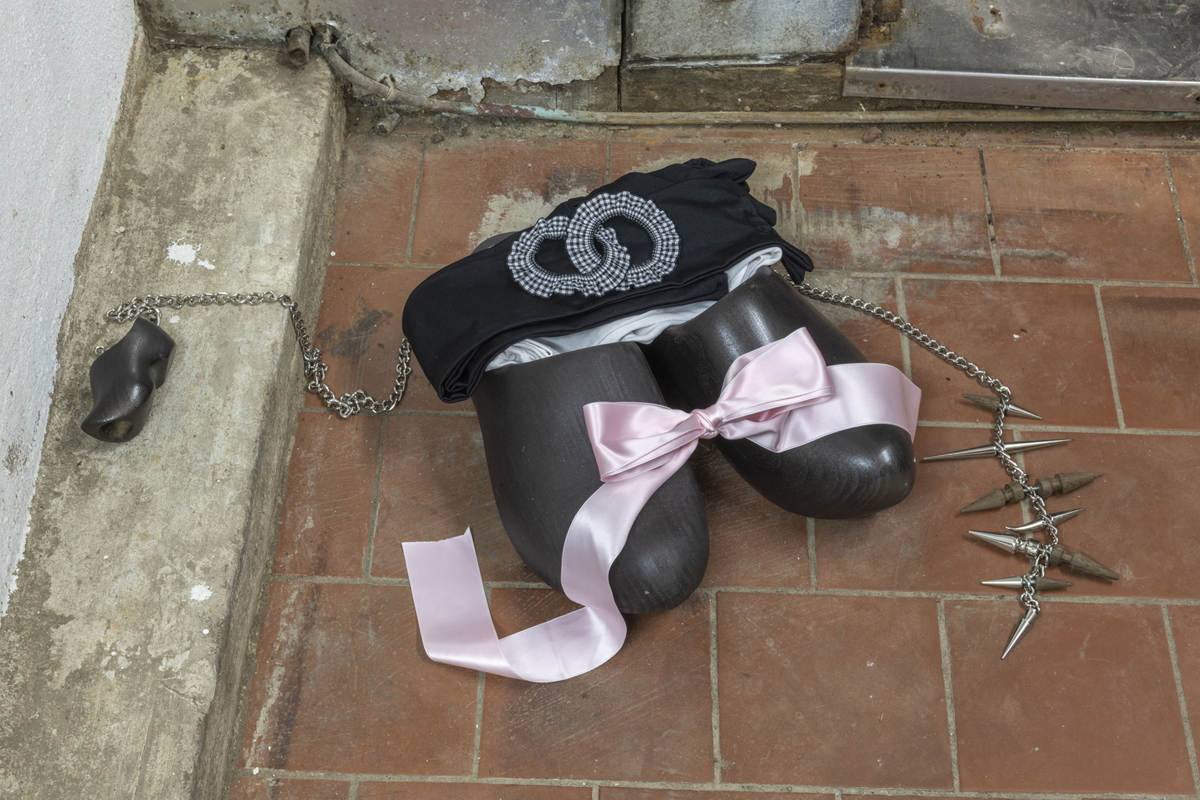
Opening reception: Friday September 13, 7-10 pm with a performance by Lilumnia
Curated by Tore Zhang and Francisco Correa Cordero
ASMA, Mercedes Azpilicueta, Daniel Baird, Luna Ghisetti, Youri Johnson, Madeline Jorn, Julian-Jakob Kneer, Masha Kovtun, Bryce Kroll, Santiago Licata, TARWUK
I slept in horrors place / names turning in the jaws of hounds / caves for abominable games / selection for the end times
good things are performative / bad things are speculative / bad people are performative / good people are speculative
in the silence of the well / a further branch whispers / its snow-covered limb / longs for nakedness. — Madeline Jorn, 2019
http://undergroundflower.com/lubov.html
Image: ©Julian-Jakob Kneer, sadocute, 2019. Lacquer on wooden shoes, polyester pantyhose, satin gloves, silk ribbon, cotton cuffs, metal chain, metal spikes, wooden spikes, nail. Dimensions variable
#34 • August 18–September 21, 2019: Complete Metamorphosis at Super Dutchess, 53 Orchard St, New York, NY
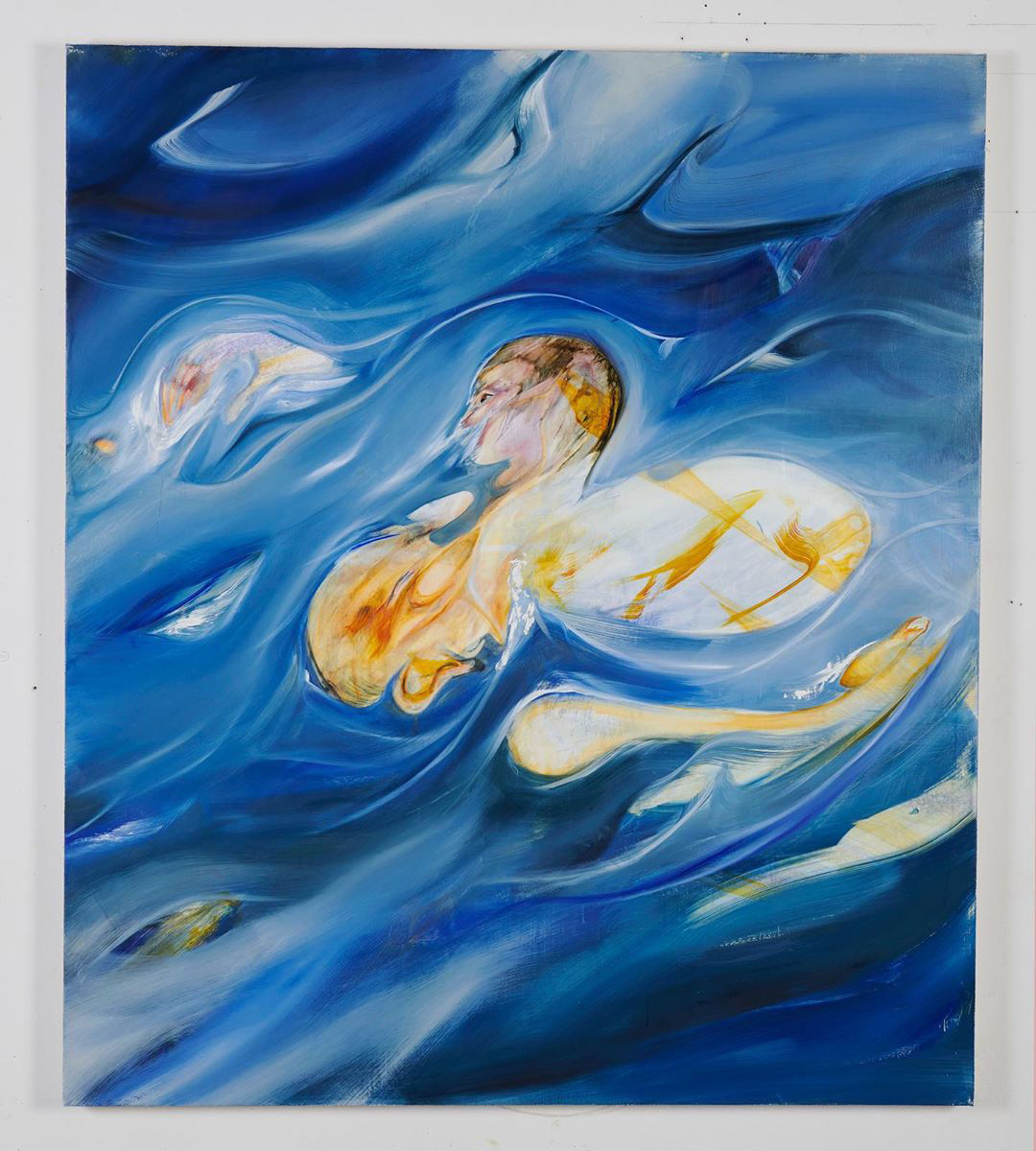
Opening reception: Sunday August 18, 4-6 pm
Curated by Francisco Correa Cordero
"Since the beginning of time, there had been the people who simply did not like reality, who wanted another world, and if given half a chance would live there forever. Some of the best warlocks might be of this type. Such people content to live in an urbapt, to spend all their money on processing and life-support equipment, to spend days at a time in the Other Plane... They grew more and more adept, more and more knowledgeable–while their bodies slowly wasted. Could imagine such a person becoming an evil thing. It would be like a spider sitting in its web, its victims all humanity." — Vernor Vinge, True Names
Whatever is going on in the world, there is another place to be. Another world rendered as pure possibility. A home for the mind and heart. Body disappears. Memory and imagination are absorbed. Spirit migrates from the body to a world of total representation.
Complete Metamorphosis brings together the work of 6 artists–Wiley Guillot, Kaito Itsuki, Bryce Kroll, Daffy Scanlan, Stefan Schwartzman and Blair Whiteford–whose work in sculpture, painting, and drawing reflect expressions of restlessness and anxiety in an age of progressive denaturation. These works transpire a desire to exist beyond the drag of the meat and the flesh.
https://super-dutchess.squarespace.com/metamorphosis
Image: ©Blair Whiteford, Deluge, 2019. Courtesy of the artist.
#33 • August 15–September 22, 2019: Hotel Heaven at Lubov, 5 East Broadway, 5th fl, New York, NY
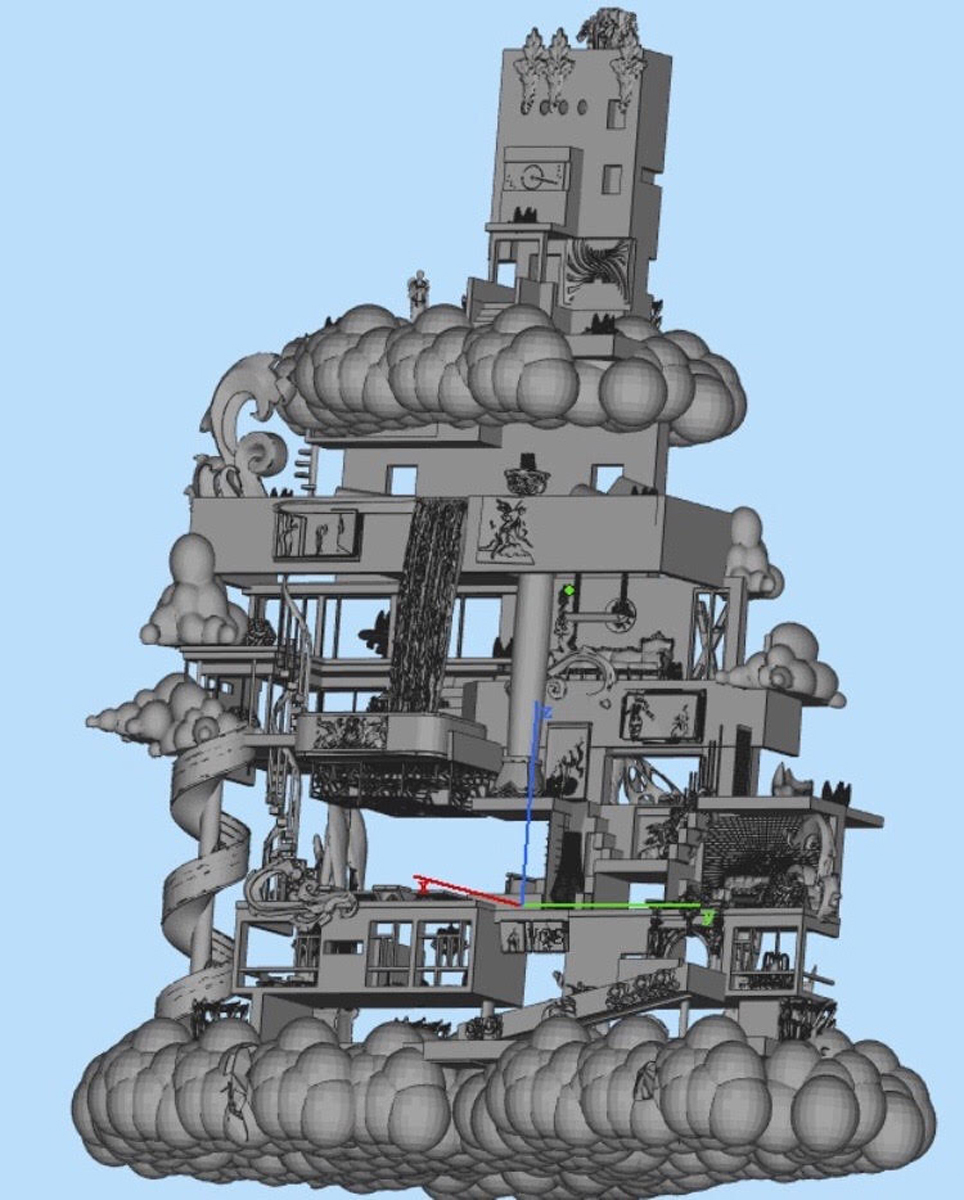
Opening reception: Thursday August 15, 6-9 pm
H stands on the roof of the roof of the roof, surrounded by clouds.
If you see the wonder of a fairy tale You can take the future even if you fail I believe in angels Something good in everything I see
The music drifts up from the club three floors below.
It's a remix of ABBA's "I Have a Dream"
Raphael remixed this song for her. It was a joke and an anthem.
Angels love the ABBA.
She loved ABBA, she loved many, many, many things, she loved her cat and her beautiful clothes that fit her perfectly, she loved to swim and dance and make music, she loved all the creatures of the earth and sky. She was an angel, she had infinite love, infinite joy. She had, if she wished it, an infinite summer, infinite day or night, infinite floors of wonder, in an infinite building that existed in dimensions that no mortal could apprehend.
The city of angels spread out before her and H shared an eternal ecstasy with every citizen.
If there is nothing missing in her life, then why do these tears come at night?
Angels also love Britney Spears, but only her sad songs.
H lets the fur slip from her shoulders. She walks to the edge of the building, climbs onto the parapet, turns her back to the city, folds her wings, closes her eyes, and throws herself out and down, down and out.
https://lubov.nyc/genevieve-goffman
Image: ©Genevieve Goffman, digital model for A New Saturday Night Whenever, 2019. Courtesy of the artist.
#32 • August 15–September 22, 2019: Rawr means I love you in dinosaur at Lubov, 5 East Broadway, #402, New York, NY

Opening reception: Thursday August 15, 6-9 pm
Curated by Daisy Sanchez
Rawr means I love you in dinosaur initiates a dialogue between two bodies of recent work through which Philadelphia-based painter Riley Hanson and Frankfurt-based multidisciplinary artist James Gregory Atkinson utilize digital photography as a means to investigate the connections between the gendered dress expectations and emotional vulnerability in various subcultures.
Hanson's portraits of emo and scene teenagers paint a tender tribute to the seditious youths that pioneered transgressive self definition through a merging of online and actual identity, and embraced gender expectation defying modes of dress and embrace of emotional vulnerability. Hanson's portraits of scene and emo teenagers are rendered from found images culled from a variety of online sources. Painted in swift strokes, the quality of Hansons execution recalls the crude pixelation of early digital phone and webcam photogra–phyprofile pics showing off fresh snake bites, moody mirror selfies in tight fitting tees, and tagged shots of friends in heavy eyeliner and helmets of dyed hair–online relics of this community. These snapshots arent intended to resurrect individual likenesses but rather construct characters that embody and enliven their collective memory.
The emo subculture that emerged in the beginning of the new millennium initially sprung from a genre of alternative rock characterized by dark, emotional lyricism. Members of this milieu of disenfranchised youth existed both on and offline in the disparate landscapes of ethernet realms and real world terrain. Alienated from their normie peers and the confines of mainstream culture, they were relegated to the fringes of early social media platforms Friendster, MySpace, and later Tumblr; they congregated in the mall Hot Topics whose signature camp aesthetic, part sinister, part whimsy, came to define their defiant style in which differences in gender presentations were slight or not existent.
Atkinson's large scale digital photographs, Hypersensitive (Blowing things out of proportion) I and II, capture moments of emotional and identity performance through closely cropped shots of crying eyes wearing costume contact lenses. Atkinson's photographs nod to the relationship between the photographic lens and the ocular lens, both transmitters of visual information and mechanisms for creating images, which often serve as the basis of identity formation. Bulbous tears well up the inner eyelids and lashes of the hypersensitive glazed over eyes sporting lenses printed with a pink heart motif and black and white zebra print. As their titles suggest, the scale of these inflated images depicting intimate moments of vulnerability alludes to an overblown, emotional response perhaps emboldened by the masking effect of the costume lenses. Conjure up associations with The lenses obscure the iris and conceal the wearer's identity, which is further abstracted by the close crop, enabling them to take on a constructed identity of their choosing.
Costume contact lenses have been donned by countercultural icon Marilyn Manson or more recently, sported by models on the Balenciaga FW19 runway. Manson's provocative persona is born out of gender fluidity and the Balenciaga brand is in part defined by their similar resistance to gendered expectations, having defied industry standards by integrated their men's and women's runways into a single unisex presentation backdropped by the techno club music.
Rawr means I love you in dinosaur, often abbreviated as Rawr XD, may be read as an infantilistic statement indicating regressed maturity could alternatively be understood as a signal of social progression. The cutesy linguistic maneuver of this memetic 'baby talk' phrase resonated with many across the vast digital plains as a way of expressing affection without having to explicitly state emotions or be directly vulnerable. The online ubiquity of this early memetic 'baby talk' phrase, entered into the sphere of mainstream culture as a popular t-shirt slogan. Thanks, in part, to the emos and the ravers who were, by self definition, scene and club "kids" On the cultural vanguard both on and off line, their agony or ecstasy was contingent on the music at the core of their subcultures in which costume is social currency and rejections of cursory gender performance paved the way for their radical embrace of vulnerability.
https://lubov.nyc/rawr-means-i-love-you-in-dinosaur
Image: ©James Gregory Atkinson. Hypersensitive (Blowing things out of proportion) II, 2017, Archival pigment print on dibond. 65 x 43 inches. Courtesy of the artist.
#31 • June 27–July 26, 2019: CONDO New York at Lubov, 5 East Broadway, #402, New York, NY
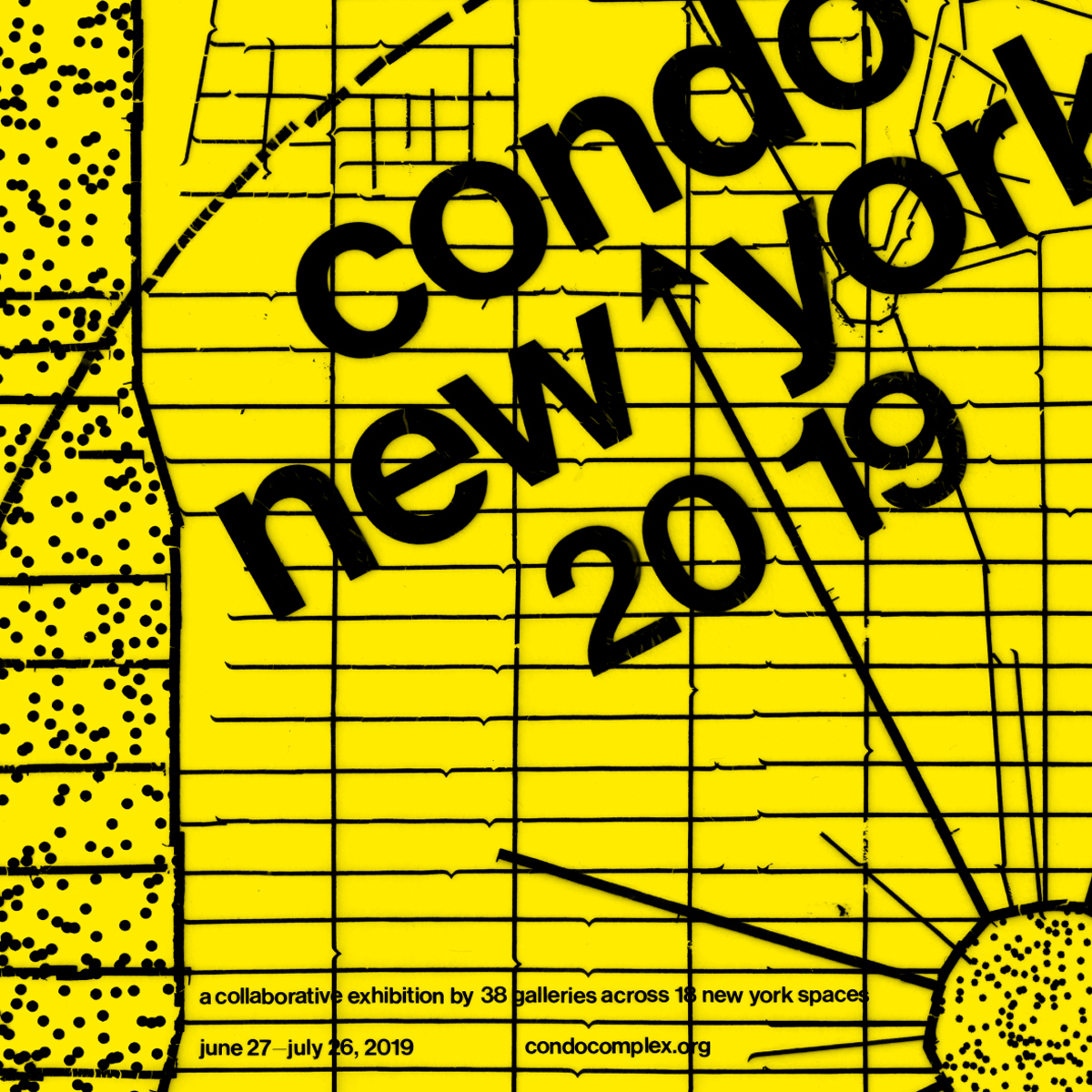
Opening: Thursday June 27, 12-8 pm and Friday June 28, 12-6 pm
Hosting El Apartamento, Havana. Presenting José Manuel Mesías
Long-running. From the farthest levels to the nearest ones.
Like composing a dramatic scenario: from scenography to the characters in the proscenium. Lack of style or, more specifically, the negation of the style, next to the inevitable (the pulse, the figurative, and the innate solution of the figures). In accordance with topics and state of mind, intention to handle a wide register of styles in each series: from naïve to academic style.
Even when objects have returned to the plane as negation or representation of the space, as fundamentalist devotion to the language of painting, painting tries to represent the depth of space-time with vehement awkwardness.
The painting as repetitive activity, as meditative activity.
To review the Cuban XIX century. To assume the mount and weeds as the homeland's botanical garden. To flow on facts and dates structure. To drop threads or reading sketches (indexes) as probable entries to that territory. Index inspired by encyclopedic tricks, escorted by four sub-indexes (hyperlinks): Ejército Libertador (EL) [Liberation Army], Herbario (H) [Herbarium], Bestiario (B) [Bestiarum], Relicario (R) [Reliquary]. A repertoire which draws on other repertoires: The José Antonio Aponte's painting book and the Yndice Alfabético de Defunciones del Ejército Libertador by Carlos Roloff; El Monte by Lydia Cabrera and Undesirable Plants by Pedro Sánchez and Haroldo Uranga; Diccionario de cubanismos o antillanismos by Alfredo Zayas y Alfonso, Esteban Pichardo, Fernando Ortiz; the Mitología cubana by Samuel Feijóo.
Mapping the independence wars imaginary and its key representations. Taking advantage of the map's blind spots and anchoring there these conjectures (images). Details and uncertainty grow between scientism and vehemence. A cabinet of wonders where findings (artificial, natural, exotic and scientific) from the traveler's explorations, delights of the curious and collectors, are grouped: pieces or pages absents, told by museums, archives, libraries, myths, passages, phrases, nightmares, relics, fetishes, portraits by memory. The symbolic architecture of the national project. To refer to the foundation stones. To deconstruct the sculpted truth, increasing the tales in a lot of possibilities.
Verse or strophe instead of the whole poem (this is: the painting). Art as other disciplines' equal (poetry, music), where love and sadness are sang, where confessions and atonement exist. Language as a complement of symbolic constructions. Its limitation for describing the nature, its erasure or blot. The attempts to codify concepts and notions: the faith, the domesticity, the emptiness, the fear.
Contingencies, the immediate eventful. Solved ideas by the finding of object or objects that propose an unexpected idea. In the smallest objects and the daily trades, we can find the basic principles of the universe. There is a special wisdom in the popular thing close to the more sophisticated knowledge. There is the collection idea, the storage idea. Accumulation of the same type of objects that can acquire systemic nature, or tell a story with its own language.
The artifice rejection. Tautologies. Coincidences. Patterns and models. The sacred. The relic. The fetish. The effort to freeze memories. Behind everything, the being's precariousness, the precariousness of all absolutes. The almost perfect balance: Theorem versus Poetry = Reason versus Spirit = Cience versus Religion.
The dirty as biological and biographic accumulation. The dirty as seed, mark, evidence. The disgust (its negation or incorporation) spread in constructive impulses. The disgust as social mark (stage, state, frontier). The dirty as corruptive element of things, of the res-publica, of the reason, like the distinctive characteristic of Havana's everyday life.
#30 • June 23, 2019: 21 Stories at Lubov, 5 East Broadway, #402, New York, NY
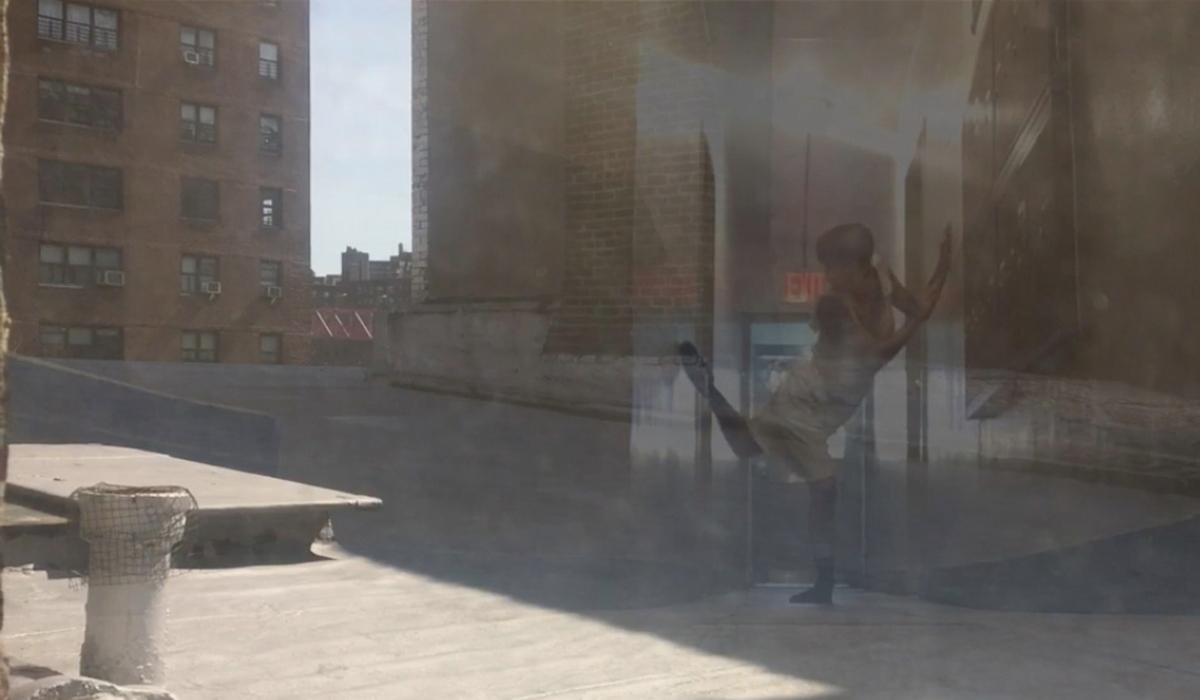
Sunday June 23, 6-9 pm
make sure that things, i don't know if they're alright so i reach out and say, have a great... cheerful messages and i just, even if i'm not feeling make sure that things are alright, and i don't know if it works have a great...
#29 • June 21, 2019: I Cannot Be There, But I Am Here at Room 4, 474 Haywood Rd, Second Floor Asheville, NC
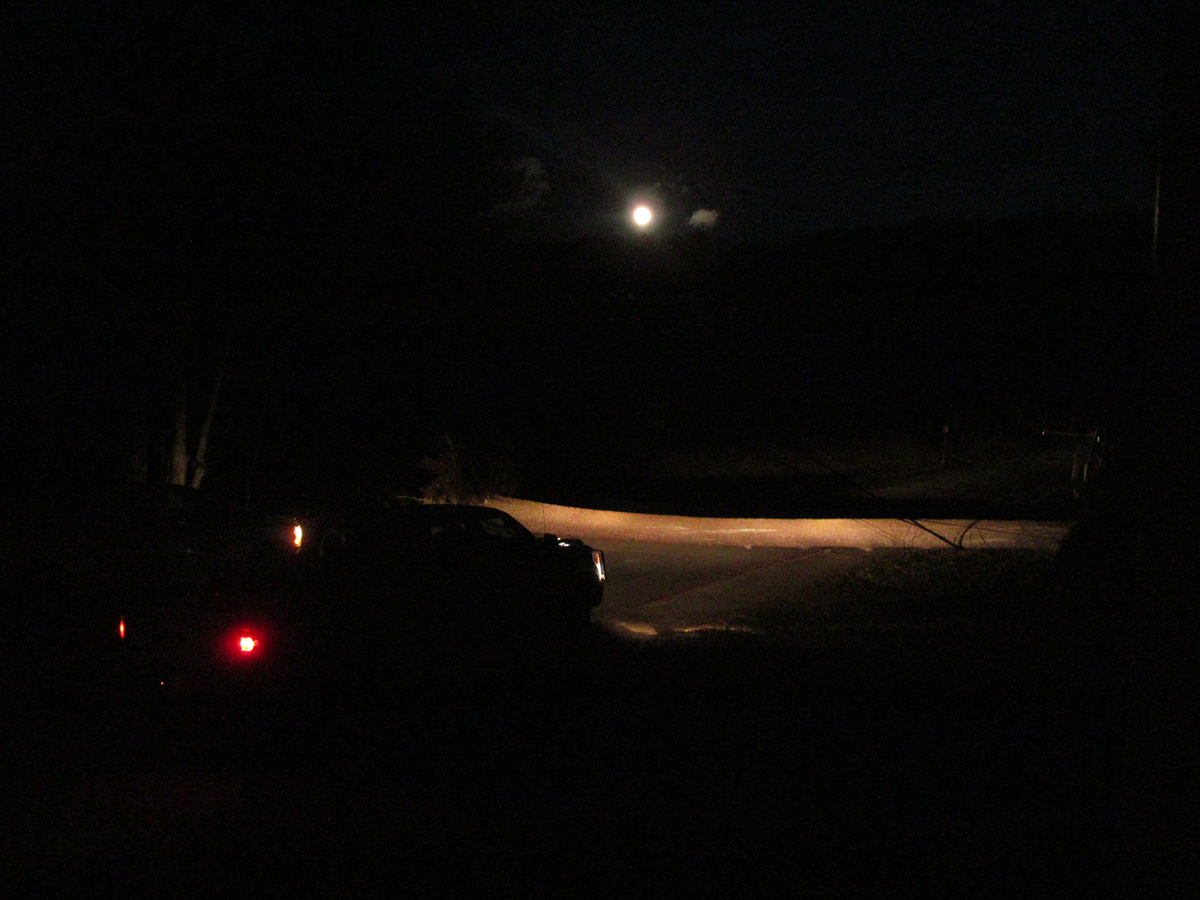
Doors 8 pm, performance 8:30 pm
New York places a call. A small southern city answers, this time from it's doorway. You are asked to come in and look around. I Cannot Be There, But I Am Here is a Twitch-stream reading between Natalia Panzer (NYC), Frances Daugherty (NYC), and Johanna Owen (Asheville, NC). For one night, Room 4 of Asheville, NC and Lubov (Room 402) of New York, New York will share a space that is contingent upon their virtual correspondence while performing in two places at once for an audience that will span the eastern coastline. We are in the time of many-to-many.
The script experiences placehood in an interstitial zone formed by anecdotal data, observational poetry, investigative journalism, and soap opera. Solitary gamers of the flesh world navigate overlapping walkthroughs of personal maps. Intersections form at the corners where we roam, intoxicated, en route to that ever-elusive "home." You are accosted, agitated, loomed-over by authority figures and disoriented strangers. You are stumbling along the path of four conversing stories. Transportation, by train or by highway, is drama on its way to itself.
The Southeastern USA is full of vast spaces, but empty of free spaces. In New York, the corridors clamor with interstices of no-man's-land. Frances muses on a past of Eastern North Carolina's outer-urban subdivisions. Johanna loots and is looted at the height of Western North Carolina's real-estate boom. A group of quake-dealers are vignetted in Gastown. Natalia bears witness on the train from New York to Newark.
It begins like this: You loot a foreclosed home of molding familial artifacts, including a crystal bowl. A ponderosa pine falls over one day, separating the new homes from the old. The power goes out in your bedroom. Your flashlight rolls under the crystal bowl, projecting its carvings all over the walls. You climb over the tree to return the bowl to an Episcopal church across the street. A public service truck stalls with its headlights on. It is parked in front of the tree for several hours. This year's first full moon lingers overhead. You wait for New York to call.
#28 • June 15–June 30, 2019: Absolutely thing… at World Pro News, 5 East Broadway, 4th & 5th floors, New York, NY

Opening: Saturday June 15, 7-10 pm
Organized by Francisco Correa Cordero
There is some muddle in the corner that reeks.
And she can hardly taste anymore,
the elegance of the object matters enough for her to want to eat.
What could possibly be the point of that?
A sense of being maybe.
The connection extends only as a favor,
to take it and eat it.
I am not sure why,
but it looks great!
#27 • June 7–July 4, 2019: 28 Days, 6 Hours, 42 Minutes, 12 Seconds at Mikro, Sihlquai 125 8005 Zürich, Switzerland
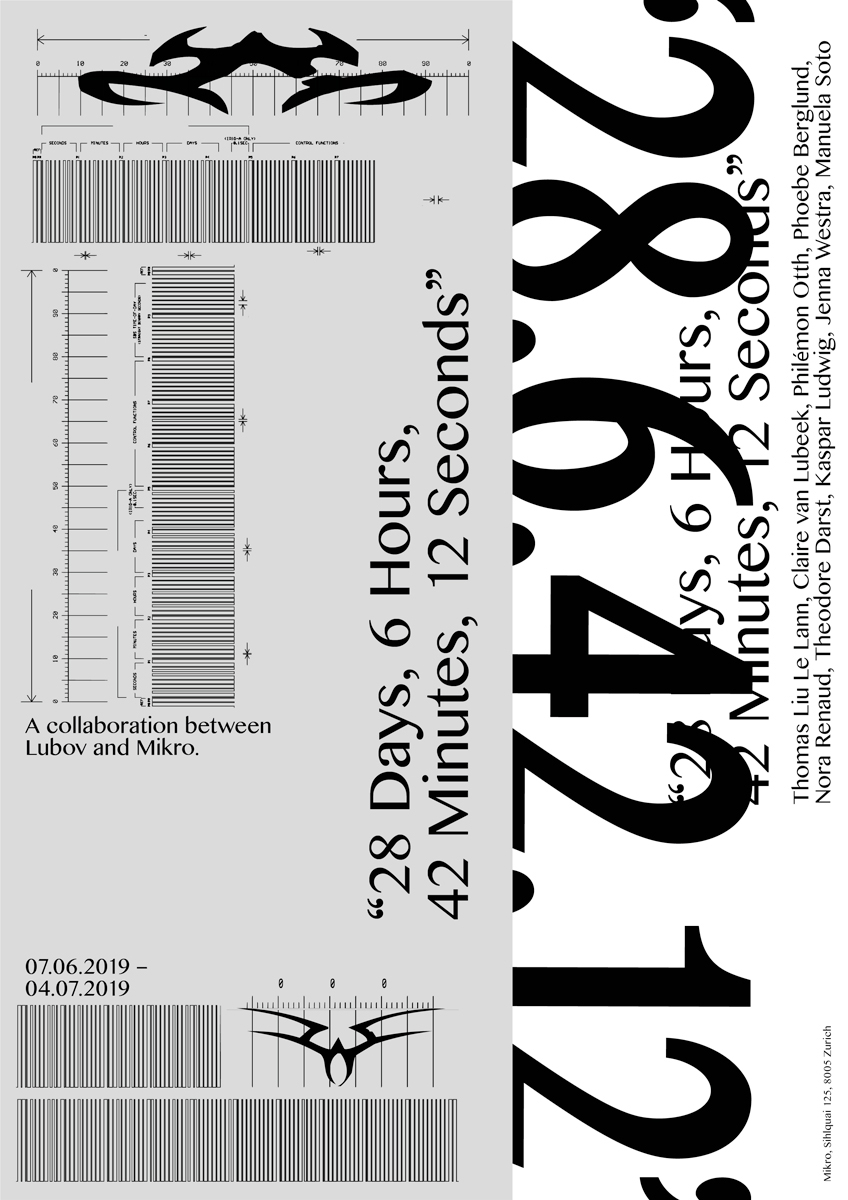
Opening reception: Friday June 7, 6 pm
Works by Phoebe Berglund, Theodore Darst, Thomas Liu Le Lann, Kaspar Ludwig, Claire van Lubeek, Philémon Otth, Manuela Soto, Nora Renaud and Jenna Westra. Co-organized with Olga Generalova and Domenico Ermanno Roberti.
A defined timeframe is a space and place in time within a continuous narrative, where and when something occurs or takes place. In writing, it is the setting of a story, the milieu, as well as a chapter in a book, a single sentence emphasizing a dialogue, a statement between two commas, a qualifying word among two brackets. Parenthesis and brackets are either a pair of marks ( ) [ ] or the information inside them. The words define both the structure, the act, the object and/or the content - framing what should be considered as "separate" from a dominant structure.
Hierarchies on the utilization, appreciation and formulations of our time are rather spontaneously unfolding while being a constant subject of questioning. In a fluid becoming, in and out of our states of awareness, we experience dreaming not just during our sleep, but also when we indulge into fantasies about something we cheerily aspire to - an ambition or an ideal - codifying juxtapositions between what is real and what isn't. A single episode - an image, an object, a sound, a gesture - can simultaneously evoke an awakening, reconnect to a past experience and assemble a forthcoming memory. The same episode differentiates in perception from one recipient to another, conveying a multitude of ambivalences that lay the ground for interpretation and imagination.
When the protagonist of the 2001's Richard Kelly homonymous sci-fi movie, Donnie Darko, learns that the world will end in 28 Days, 6 Hours, 42 Minutes and 12 Seconds, the assumptions of the existence of more than one reality are built into the narrative. In fantasy fiction, a parallel or tangent universe is a hypothetical, often time-bound, self-contained existence adjacent to someone's own. While the idea of imaginative, alternative material realms and narratives is long borrowed from mythology, the methods for connecting these places to ourselves through objects and histories is constantly evolving, perhaps even expanding with the advent of cyberspace.
Fictitious domains are linked to our sphere through portals or items, which are the thresholds to a different somewhere. The artistic intervention, when quoting our realm embraces repetition as an inherently transgressive approach where subjective reading, manipulation and irony are interpreted as lines of escape from the generalities of society, distancing themselves from the norms while re-enacting them. Traces and fragments are signs of a presence or a passage, attempts to cross a border, define their edges and explore their representation.
– Domenico Ermanno Roberti, Zürich, June 2019
#26 • May 10–May 26, 2019: Staying near you at World Pro News, 5 East Broadway, 4th & 5th floors, New York, NY
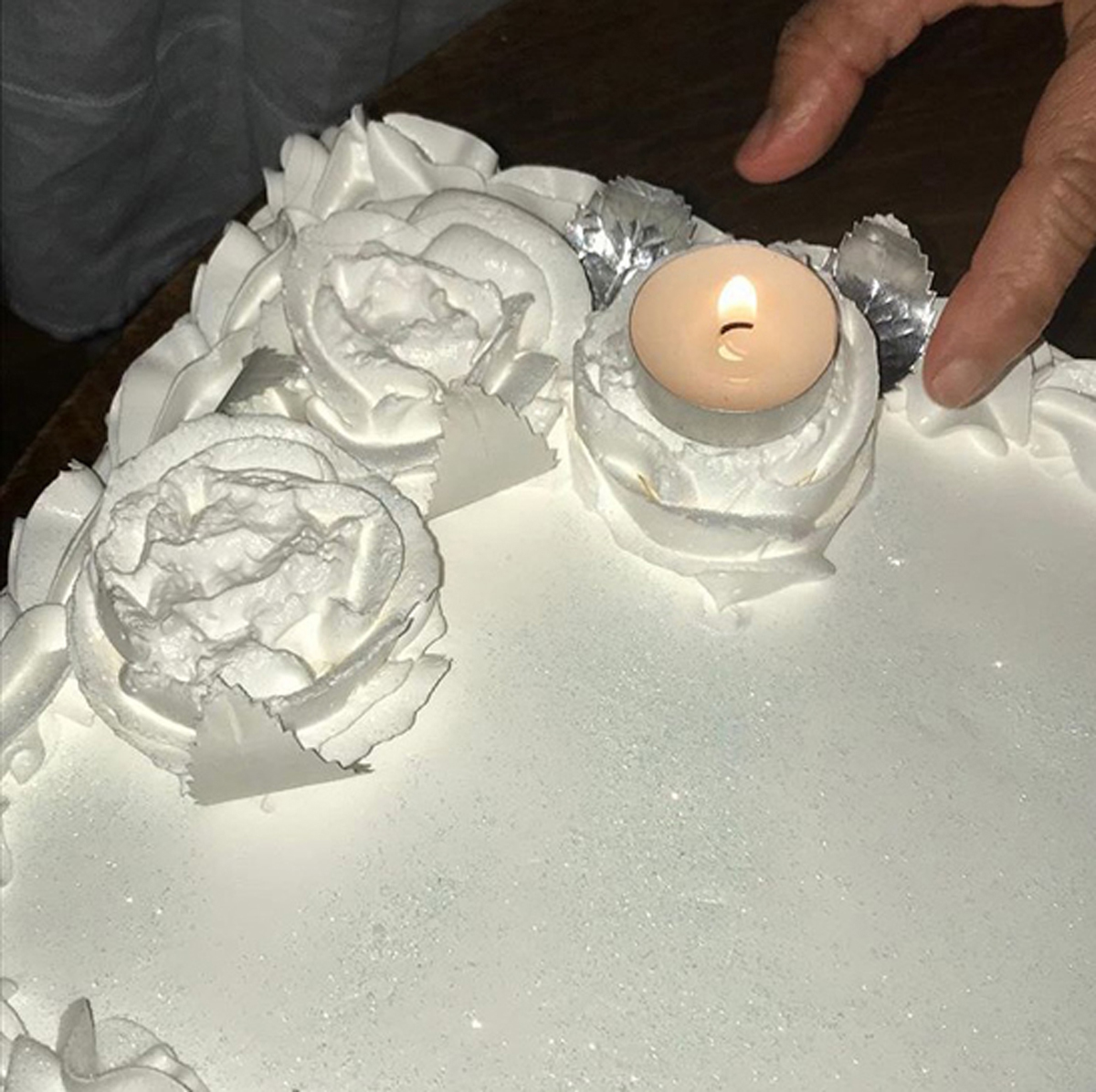
Opening reception: Friday May 10, 7-9 pm
Chapter 4: Jane Balfus, Dakotah Murphree, Deirdre Keough
Organized by Francisco Correa Cordero
Only the homemade theories we create out of our shared lives really help us to make sense of everything we are and all that we find to love. – Aurora Levins Morales
You probably won't see this but it's worth a shot. I have so much more to tell you and ask you! You still have no idea I exist...
Oh,
...We are a place inviting you It is not prescriptive It is nuanced and forever morphing It is so tender to look with a chapter four gaze because this serves as a reminder that there is so much depth and beauty in fragmentation The irrepressible sense of wonder and hysteria that comes with loving deeply
Kind eyes are currency to me How lovely it is to find sisters who cast themselves in understanding True sisters give the gift of ornamentation The layers are sown
Make me feel like a braid does Aware of its roots Dependent on interweaving And forgiving of lost strands
Misshapen things Truly some detritus of that not said realm, Sat on that word, on the discrepancies
A stain casts a shadow The sweaty mark climbs
I carried it on my back and into a field Her hands answered in stones:
I believe and I feel and I want
But we do But we do But we do
– Chapter 4, New York, May 2019
http://wpn-nyc.us/chapter4.html
Image: ©Chapter 4. Courtesy of the artists.
#25 • May 6–June 16, 2019: Great Expectations at Lubov, 5 East Broadway, #402, New York, NY
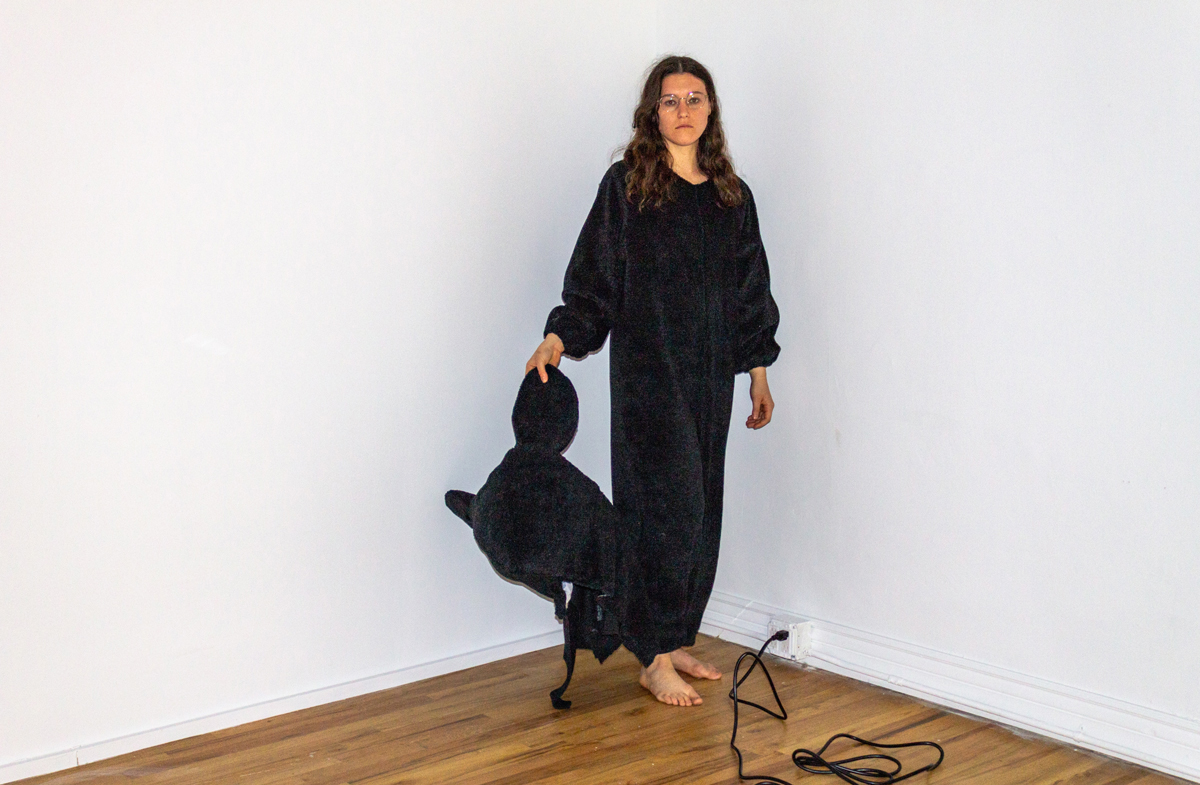
Opening reception: Saturday May 6, 6-9 pm
Characters are one place to start. Actors getting into character: grimacing or expressionless or smiling luridly at nothing. Lovers in an entwined embrace that veers toward restrained wrestling: hands clutching limbs, reaching for a head to hold, a resting position after the tumult of positioning. A supine sleeper, holding a leg perpendicular: a window onto a seemingly inactive subject.
These and other characters, let's call them "dancers," punctuate Phoebe Berglund's exhibition Great Expectations, occupying the frame of a genre that has been stripped of its assets: plot, narrative progression, character development. They move between citation and abstraction in the work's uptake of the well-known Dickens classic, reframing fictional continuity as episodic activity staged sporadically within the gallery.
Inside the gallery are objects, let's call them "sculptures," whose temporality is more ongoing. Take these sculptures by Arkadiy Ryabin: a fountain that seeps mist (the mist-maker), concrete casts that index the shape of circulating commodities (surrogates). Surrogates syphon energy from the body, turning expressive in relation to the body's drained affect and desubjectification under late capitalism.
Outside the gallery, Dicken's 19th century London has transmogrified into 21st century New York. The dancers drag this urban landscape inside: they organize into the outlines of high rises, reconfigure their bodies as sculptures that pass for public art, and encode the ruinous sight of real estate development into the soft architectures of their amassed bodies. Outside is also Broadway, and the elastic repertoire of dance and theater histories acted out on its stages. The dancers seize and adapt phrases and gestures from this repository. These phrases are like nouns endowed with new adjectives in sentences that remind us of a text which is in the process of being rewritten.
Such enactments and reenactments produce new alignments: between embodied memory, static constructions, and choreographic movement. Clusters of dancers move between these registers under the sign of looping, forming temporary assemblages or compositions approaching sculpture, falling in and out of objecthood. As Kathy Acker writes in her own reat Expectations, "there is no lineality of time time is an almost recurring conical."
– Rachel Valinsky, New York, April 2019
https://lubov.nyc/phoebe-berglund
Image: ©Phoebe Berglund. Courtesy of the artist.
#24 • March 16–April 28, 2019: Golem at Lubov, 373 Broadway, #207, New York, NY
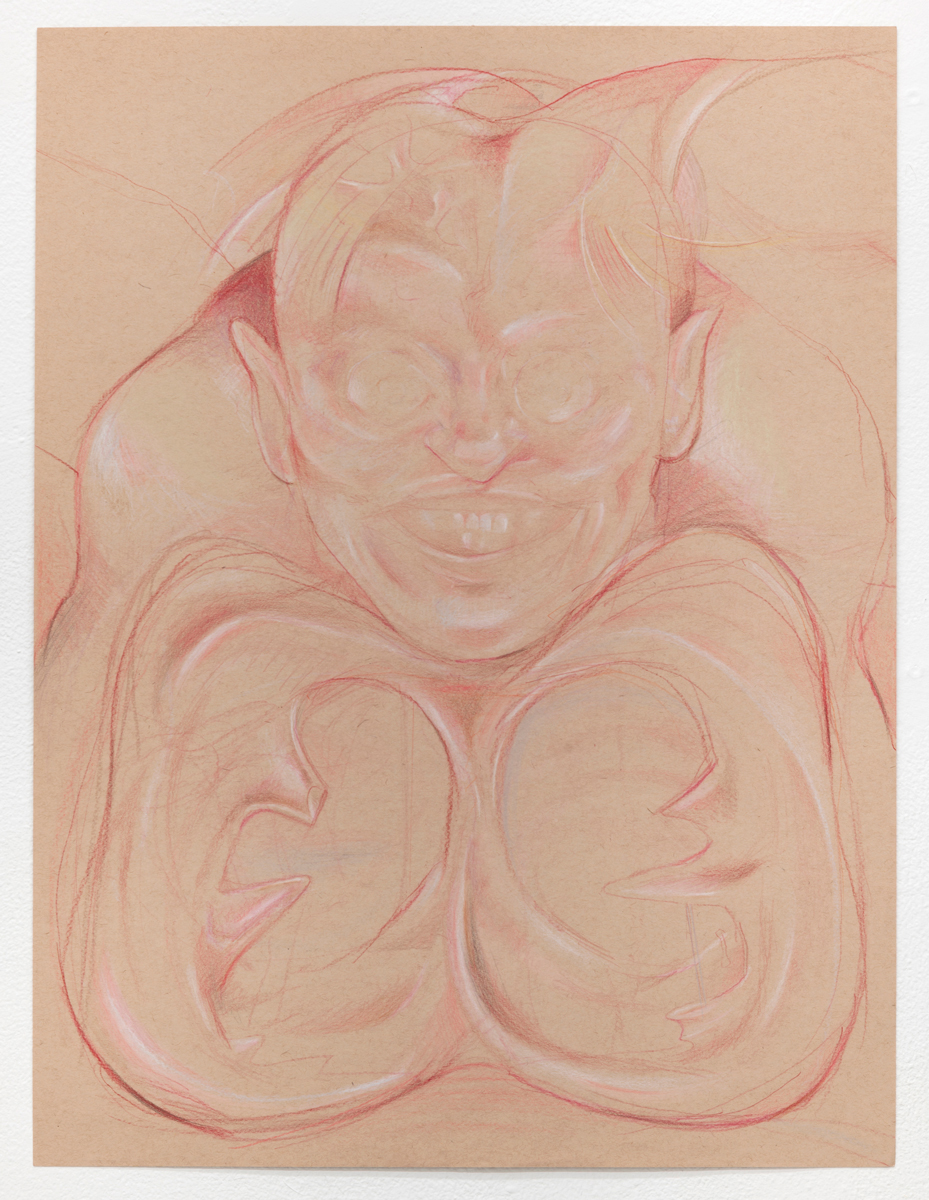
Opening reception: Saturday March 16, 6-9 pm
When you're getting fucked in the ass you get an experience that is exposing. And there is the feeling of being impaled, of being split in half. And there is a splitting of personality. Or one could say a spitting of personality, into the asshole.
Here we witness the same obsessive body reconfiguring itself over and over again. Grafted shapes descended from solar dust mowing through the frame, separating the inorganic from organic. "Bodies are bags of shit and teeth," said Stefan.
At first we are submerged in a wash of fragile greys and blues with splashes of red. It seems like the lines want to disappear but the faces and bodies linger nonetheless, smiling and wanting in pain. Wanting something and not having it, so much so that it becomes grotesque. Pagliacci watches from the rafters.
There is something fleshy about this world, maybe we are inside a body, or we are very small exploring a giant one. Or we are a very small giant. Are these figures all part of the same universe. What's the opposite of a cinematic universe? The cinematic universe cannot and will not respond to any and every question you may have prepared. We asked the golem to answer in its own way.
The most tellurian of lifeforms, cloaked and grim. Humanoid figurines dance, they are of the golem family, and we travelled great distances to meet them.
– Ada O'Higgins and Alexander Iadarola
https://lubov.nyc/stefan-schwartzman
Image: ©Stefan Schwartzman. Courtesy of the artist.
#23 • January 19–March 3, 2019: Anagen at Lubov, 373 Broadway, #207, New York, NY
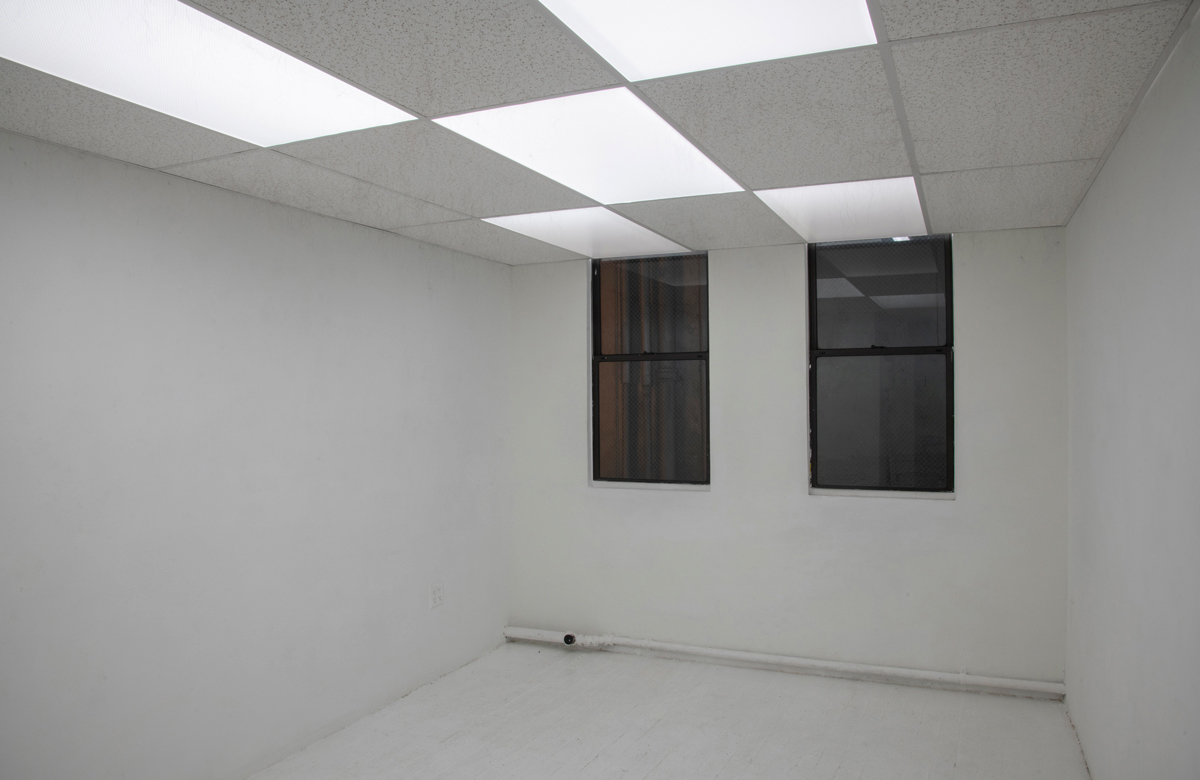
January 19 - March 3, 2019: Mira Dayal: Anagen at Lubov, 373 Broadway, #207, New York, NY
Opening reception: Saturday January 19, 6-9 pm
You notice a string of fortuitous coincidences. The artist's given name is an invitation for you to look, if your ears are primed to another of the many languages spoken in this city. In other tongues it conjures the ocean or myrrh, but at this point the matter at hand is optical, not aural. You come to a building erected in 1915, featuring an Art Deco facade of which there is hardly a trace inside, where mazes of office spaces are replicated in each of its six floors. All doors are identical; the signs beside them are their one distinguishing trait. You don't know what to expect. You walk into suite 207 and find nothing inside. The fifth wall is a dropped ceiling. Ubiquitous in institutional spaces and basements, dropped ceilings were patented in 1961, their purpose both cosmetic and acoustical. You wonder where else they might be in the building, which otherwise boasts tin ceilings as markers of its past. Later you'll find out that the union in charge of "Operation Price Watch," which monitored violations of Nixon's 1971 anti-inflation ceiling on prices and wages, once had this address. The union's offices conceivably had a ceiling like this one. You wouldn't want to go around exposing your wiring and ductwork, would you? Who doesn't want to hide their structural damage? Even less on the big day. You're having thoughts of the intrusive, incongruous variety. You look up. A satin sky. If walls have ears and doors have eyes, why can't the ceiling grow hair? Hair" is everywhere, trying to tell you something. Dropped ceiling. You repeat the phrase to yourself enough times to find it absurd, or comical. Dropped or fallen? When something has been dropped it hasn't fallen on its own, as hair does. Women lose between fifty and one hundred strands a day on average. What you witness, however, falls in the category of the supernatural. Causes of abnormal hair loss include stress; eating disorders; and styling routines such as daily blow-drying or curling, harsh or compulsive brushing, and the application of bleach, dyes, and relaxers. The unmistakable drone of dryers leaks down to the gallery space from the AK Beauty Bridal salon immediately above, in suite 307, but as you leave the building, there are no brides to be seen.
– Mónica de la Torre
Image: ©Mira Dayal, Anagen, 2018-19. Armstrong ceiling tiles in dropped ceiling in gallery, human hair, glue. 86 x 117 x 203 inches (approximately). Courtesy of the artist.
#22 • November 10–January 6, 2019: Toy Temple Human Monk at Lubov, 373 Broadway, #207, New York, NY

Opening reception: Saturday November 10, 6-9 pm
Curated by Dana Kopel, with gratitude to Charlie Markbreiter
Auditorium filled by sulfuric odor. Confrontation of inner banners. Evidence of overturning baby-cells. Trash fire blurs free embers on the mat.
Meanwhile, Chiara Ibrah and Daffy Scanlan are bombarded by unrelenting apocalypse dreams. They see people trampled to death by shredding cleats, disintegrating during transportation, decrepit while weighing little. Plagued by visions of decay and rebirth, Scanlan and Ibrah give agency to the space that exists between these two extremes, creating a map by which the monk should navigate his toy temple. In doing so, they bombard viewers with the promise of a confrontation that someone traversing an unfamiliar landscape might endure. As if cracked over the head by an iron pipe, the viewer bears witness to a memory distilled from the artists' nightmares, and must drag themself upon hands and knees through the metallic carnage that drapes the gallery space, punctuated by doom and beauty. The linearity of such a journey, however, remains obscured by abstraction–resolution shattering like shards of glass, glimmering sacredly to tantalize the viewer.
One feels obligated to approach the work skeptically, with the caution of someone that has tasted devastation. Flung inward by the inertia of solitude, one is forced to understand their own humanity through the scratched lens of the landscape swirling around them.
– Daffy Scanlan and Chiara Ibrah
https://lubov.nyc/toy-temple-human-monk
Image: ©Chiara Ibrah. Courtesy of the artist.
#21 • October 16–December 15, 2018: PLS at White Columns, 91 Horatio Street, New York, NY
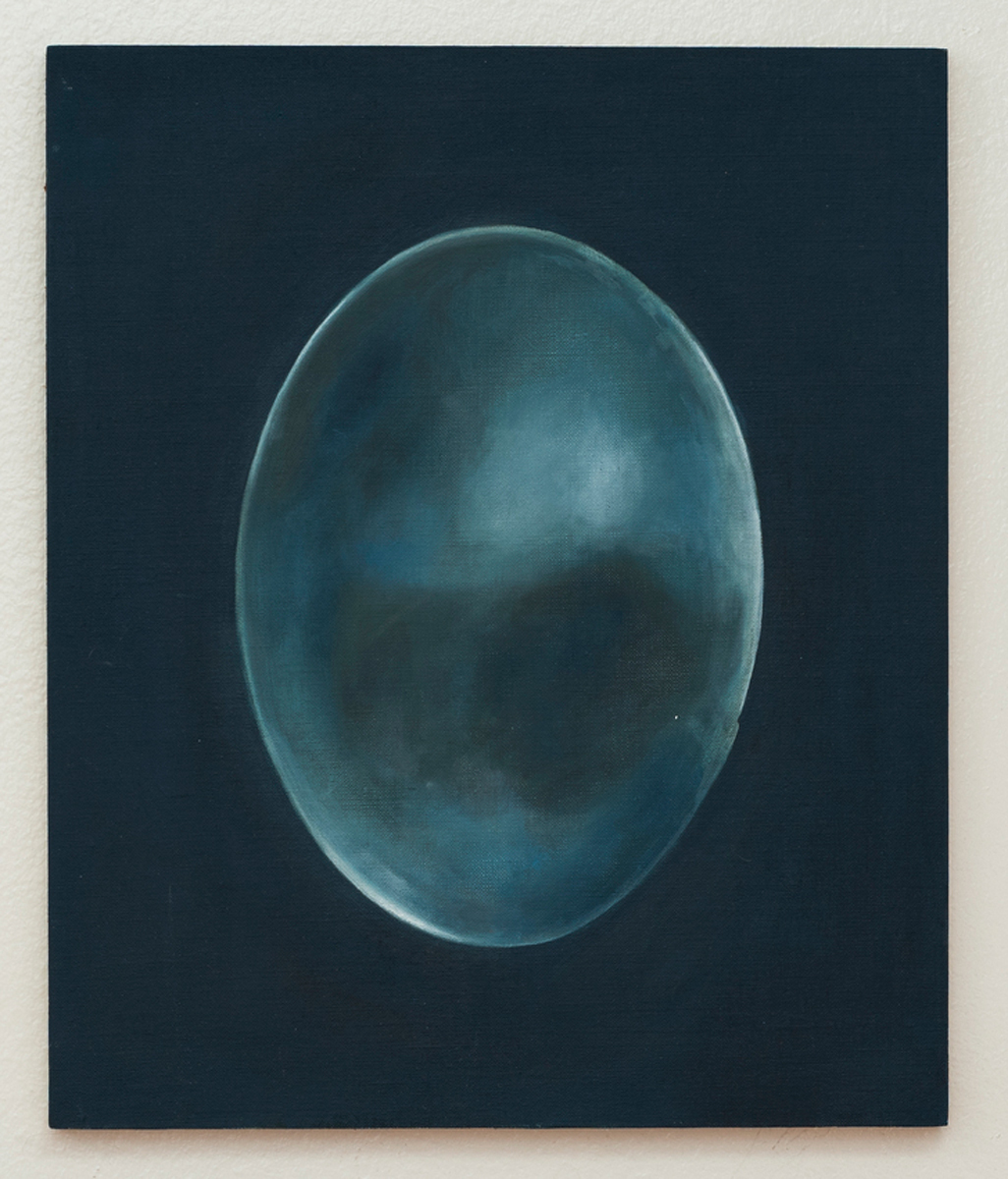
Works by Daryl Bergman, Jerry Blackman, Gabriel Simon Cohen, Kristine Eudey, Nicolas Fleming, Tania Jade Houtzager, Daniel Jensen, Katie Kirk, SaraNoa Mark, Chris Pousette-Dart, John J. Richardson, Barb Smith.
Curated by Francisco Correa Cordero
"A limit can be understood as something to be pushed and/or reached beyond; as a maximum or minimum capacity to act; or, as the threshold beyond which one can never reach. The limit, then, is highly significant to our understanding of what a body could be and its inhabitation of space. Uncovering, experiencing, or experimenting with what, where and when the limits of the body are, [...] can make evident or potentially disrupt our notion of what it means to be a human being in the world." – Sebastian Abrahamsson, The limits of the body: boundaries, capacities, thresholds (2011)
"PLS," short for "phantom limb sensations" or "phantom limb syndrome," refers to the feelings (sometimes pain) in limbs that are no longer part of oneself, and is perceived outside of the limits and borders of the body. It was originally believed that it was caused by the grieving over the loss of the limb, but as opposed to other types of chronic pain, psychological factors are not precisely the cause. In some cases, this feeling is perceived in limbs that never existed in the first place. It is actually due to a reorganization of the nervous system. This peculiar phenomenon and adaptation to new conditions, is at the core of this exhibition.
Augmentation, loss, longing, allusions to schematics and a desire to reach and see beyond what is perceived are among the themes in the work of the artists included in PLS; each responding with different degrees of anxiety and tension to their environment, their own limits and their own materiality.
Under certain circumstances the brain's representation of the body can be extended, and can assimilate external objects as part of itself. Conversely, the brain is also able to deny ownership of its own limbs. The works included in PLS occupy an unstable space in which they are both at comfort and unease with themselves. They are familiar while compellingly strange and foreign, becoming whole in their own entropy.
https://www.whitecolumns.org/sections/exhibition.php?id=1456
Image: ©Daryl Bergman, Egg. Courtesy of the artist.
#20 • September 15–October 28, 2018: Prepositions All the Way Down at Lubov, 373 Broadway, #207, New York, NY

Opening reception: Saturday September 15, 6-9 pm
Oh, how we speak to the creaturely! In Kricket Lane's surreal visual world, it's in a series of half-imperative, partly-cooing ask-commands: sculptural portmanteaus of nature- and human-made, inspired by her love for and interactions with her dog. Human-to-animal being intra-relations have long been fodder for thought. Jacques Derrida considered his nude self before his cat, Donna Haraway probes the bonds of our canine companions' "significant otherness," and Hélène Cixous' poor, noble dog Fips became zoomorphically emblematic for the wounds of colonialism and anti-Semitism.
Derrida coined animot to linguistically replace the unnuanced animal; a written bridge to encapsulate the spirit and multitudinousness contained within critters. Lane's work dwells in that same border crossing of partnership between species and the magnificent and mundane. It's apt that her work has included comb teeth and grill grates. More uncanny objects: a shell-like husk trimmed with an infinity-curve of faux shearling; a branch simulacra is topped off with a sheep duster; a pair of green socks, delicately carved, become treasure.
Animal and human creatures share so much, from suffering to mortality and love. That relationship, constantly modified by and with the other, is at the heart of these works. In this ethical alterity, each thing or encounter is more than simply a tool or function. We come up hard on the big metaphysical truth of interdependence: we're one, many, and in our force dynamics, cannot be left unchanged.
– Yin Ho
https://lubov.nyc/kricket-lane
Image: ©Kricket Lane, Bring It Back. Courtesy of the artist.
#19 • September 4–September 9, 2018: Laura Noguera at Lubov, 373 Broadway, #207, New York, NY

Opening reception: Tuesday September 4, 6-9 pm
https://lubov.nyc/laura-noguera
Image: ©Laura Noguera. Courtesy of the artist.
#18 • August 27–September 2, 2018: On the home front at Lubov, 373 Broadway, #207, New York, NY
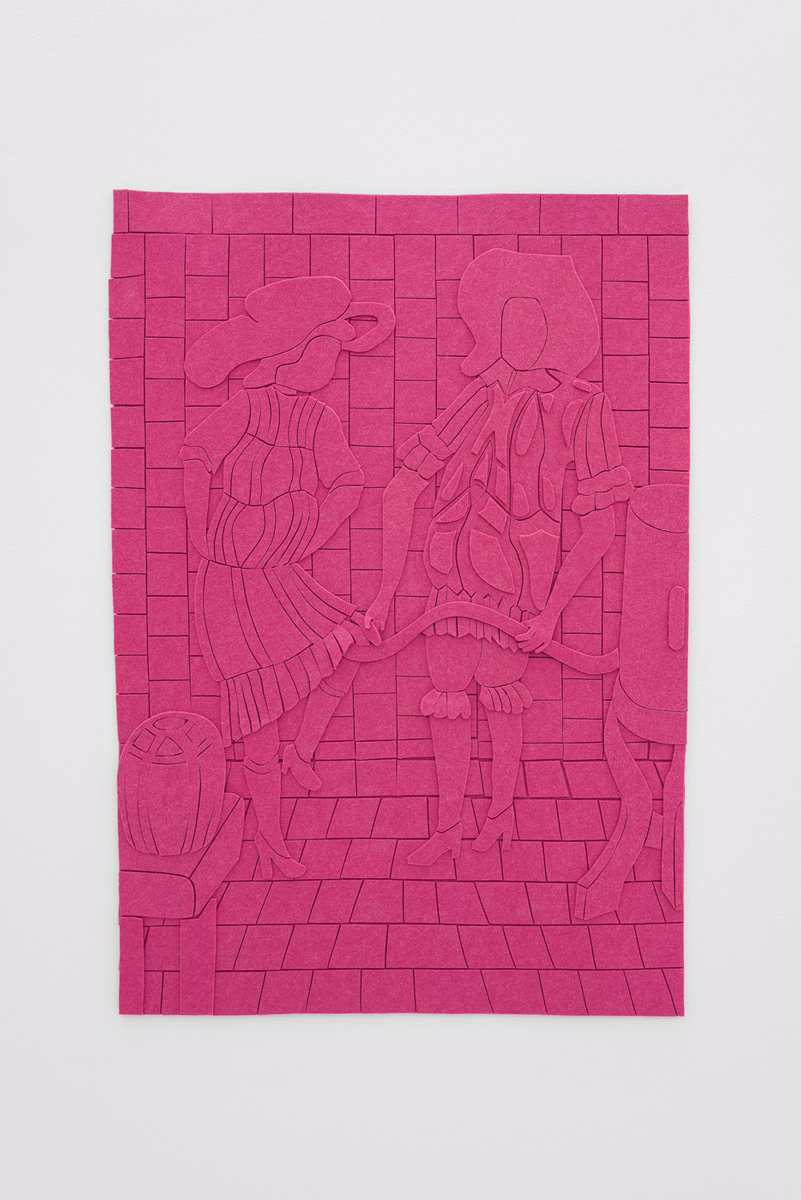
Opening reception: Monday August 27, 6-9 pm
Works by Lauren Gidwitz, Spencer Lai, Sam Shoemaker. Curated by Esme Thompson-Turcotte.
On the Homefront is an exhibition which grapples with the relationship between person and setting through the work of Lauren Gidwitz, Spencer Lai, and Sam Shoemaker. The work's strong visual kinship across different mediums and color palettes is forged through the continuity within each piece. Despite the disparity in color pallets and mediums in the works because of consistency and monochromatism present in each. Figures are established through texture and shape but are very much embedded and married to their surroundings. The motif of environments is established by lack of separation between the figures and the scenes they inhabit, attempting to delineate the accord between character and setting.
Lauren Gidwitz started using rope after her step mother, who had crafted family portraits from the material, died. She reappropriated the medium of creation from something vital to her home life, literally and figuratively. A family portrait is inherently domestic in its personal connection between people and space and place and time, Gidwitz's pieces abstracted and distorted from their ancestral inspiration, yet tied to their origins in that they too depict scenes of home and family life. Gidwitz utilizes a myriad of construction materials to realize her pieces such as cardboard, amberized archival glue, drop cloth, and balsa wood, all part of a consistent color profile, yet diverse in texture. Though the graphic prints and range of tones in the pieces are present, the figures are reliably tied to their immediate surroundings, rarely standing out from the space they occupy. The materials too are familiar, domestic and economical, none out of place in a home.
Spencer's trio of figurative compositions are rendered in magenta, royal blue, and burnt orange through layered pieces of cut felt. They each depict a distinct interaction and environment. Said figures are unequivocal in character yet wholly immersed in their environment given the singularity of materials Lai uses. Much like Gidwitz, the figures are distinguished from their background through shape rather than color. Lai creates scenes filled with motion and movement, the lines formed from the gaps between shapes, no negative space allowed given the tessellations and layering of felt.
Sam Shoemakers sculptural piece is carved from a single piece of plywood and coated in iridescent paint, the pattern carved from a digitally rendered drawing. Figures are difficult to make out, as an apparatus of sorts is apparent along the sides, which the figures depicted grip to as they hang through an indistinct foreground and background. The enigmatic nature of the space is furthered by the uniformity of the materials, the lines which form the figures all overlap and are monochromatic. The figures, glaringly different in composition, some appearing inhuman though they are all cartoonish, blend into one another despite their differences in form and genre.
https://lubov.nyc/on-the-home-front
Image: ©Spencer Lai, pink (mechanism), 2017. Synthetic felt, adhesive. Courtesy of the artist and Kimberly-Klark, New York.
#17 • July 14–August 26, 2018: Last Days in a Lovely Place at Lubov, 373 Broadway, #207, New York, NY
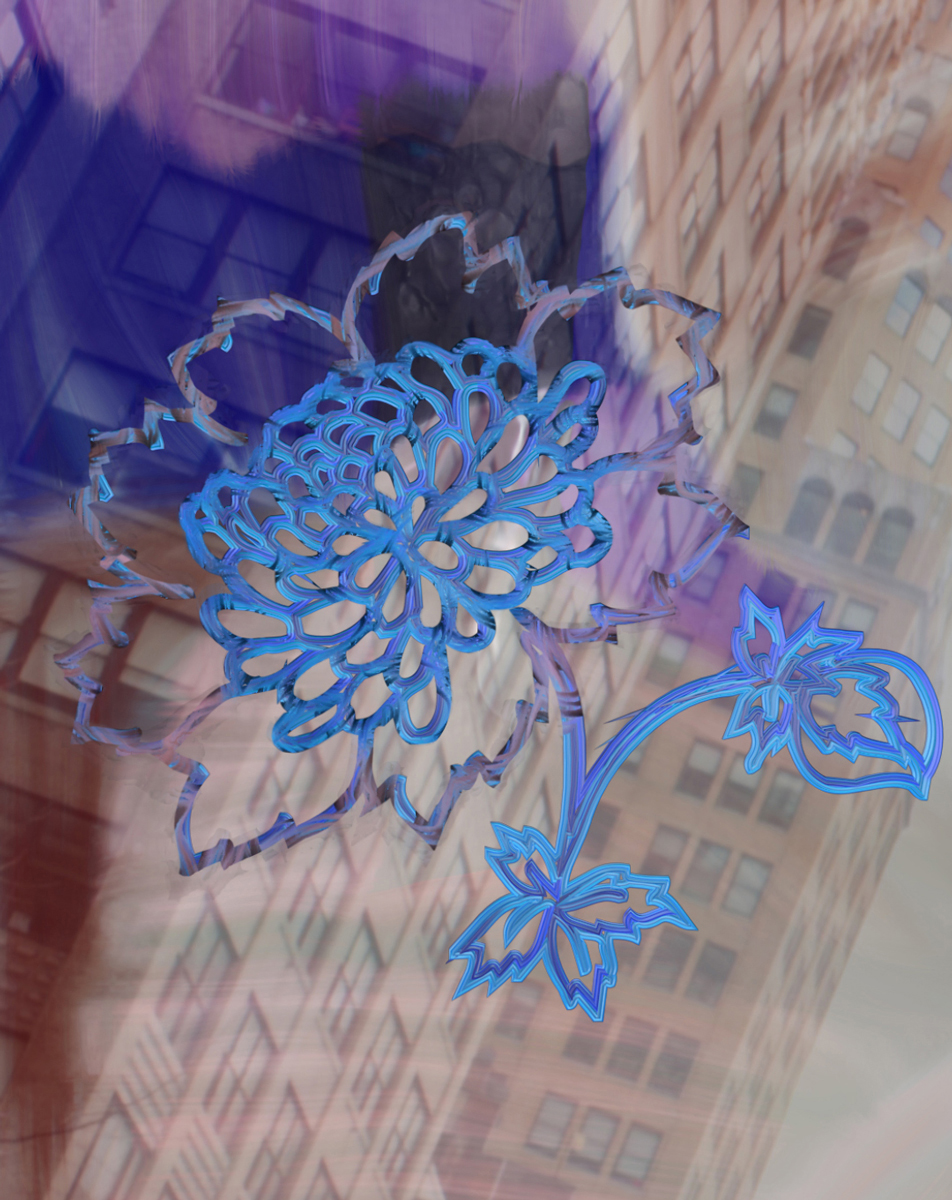
Opening reception: Saturday July 14, 6-9 pm
Last Days in a Lovely Place provides a conceptual and formal break from Theodore Darst's previous video projects. Darst abandons the highly rendered and processed landscape of professional video editing software in favor of less robust, casual mark making tools, and traditional photographic processes-counterpointing this shift is his attention to the detailed and labor intensive processes of working and reworking each image and frame.
Darst's favoring of iPhone software over prosumer or professional and industry software, points toward a simplicity of working in which technological availability is taken as a given. His critique does not lie in pressing the boundaries of computing, so much as his personal and private interactions with it. That the site of production is not only as mobile as the artist's body, but as social in this context as well, is important to the understanding of this series of subjective and objective systems through which the work makes its permutations. This downgrading, or deskilling, of Darst's practice reveals that its conceptual backdrop is located on a more personal ground. Last Days in a Lovely Place is more at home within the framework of a personal diary than that of a dark room full of strangers.
Forming subjective filtration and feedback systems, which extend from his post-studio practice, Darst leverages twentieth-century mythology of both the painter alone in the studio towards a newer but Romantic vision of the artist always connected, and always in transit. Whereas the artist's previous bodies of work function within much stricter narrative confines, reached through highly rendered productions, the subject of Last Days in a Lovely Place instead exchanges these traits in favor of disjointed feats of strength, by way of lengthy working processes.
In the series of large aluminum prints on display, as well as the single-channel video, the mobile nature of Darst's production methods is immediately recognizable within his brush strokes, which correspond roughly to the size of the finger-evidence of the artist's touch, albeit clearly mediated through a touchscreen device, which point to the algorithmic underpinnings of painting software available to the casual user. Often working on while traversing the City, by train, foot or Uber, Darst opts for self-imposed relational constraints-each session is bookended by departures and arrivals. The sentimentality of these movements joint with the artist's experience of his device, its interfaces and its denizens, coalescing into an abstract work in full field.
Mt. Sinai Movement (2018), a vertically-oriented video work, follows a similar tack in durational space-the work itself is a painting in motion. Its many visible strokes are in a state of constant flux, morphing from one abstract shape to the next, taking on the continuity of a slide show or a dashboard mounted camera. Accompanying the abstract works is a series of black and white photographs depicting close ups of male and female figures. The darkroom process used to produce the series lends something of an element of sincerity to the images. Counter to these trappings, the figures are computer generated-avatars-posable figurines that inhabit the digital surface.
Soundtracking the entire exhibition is Last Days in A Lonely Place (elegy) (2018) by Darst's frequent collaborator Kevin Carey. A poem about the highway vertigo of a drive straight west was read by online voice actors, autotuned and reedited into a quasi-narrative audio work. The work's sound expands to the whole gallery-as if playing synchronously on the headphones of each viewer-as if Darst is providing the viewer with a playlist of his subconscious.
– Nathaniel Hitchcock
https://lubov.nyc/theodore-darst
Image: ©Theodore Darst. Detail from a still from Mt Sinai Movement, 2.45 minutes, loop for 4K Monitor, silent. 2018. Courtesy of the artist.
#16 • May 25–July 8, 2018: Meant to Be at Lubov, 373 Broadway, #207, New York, NY
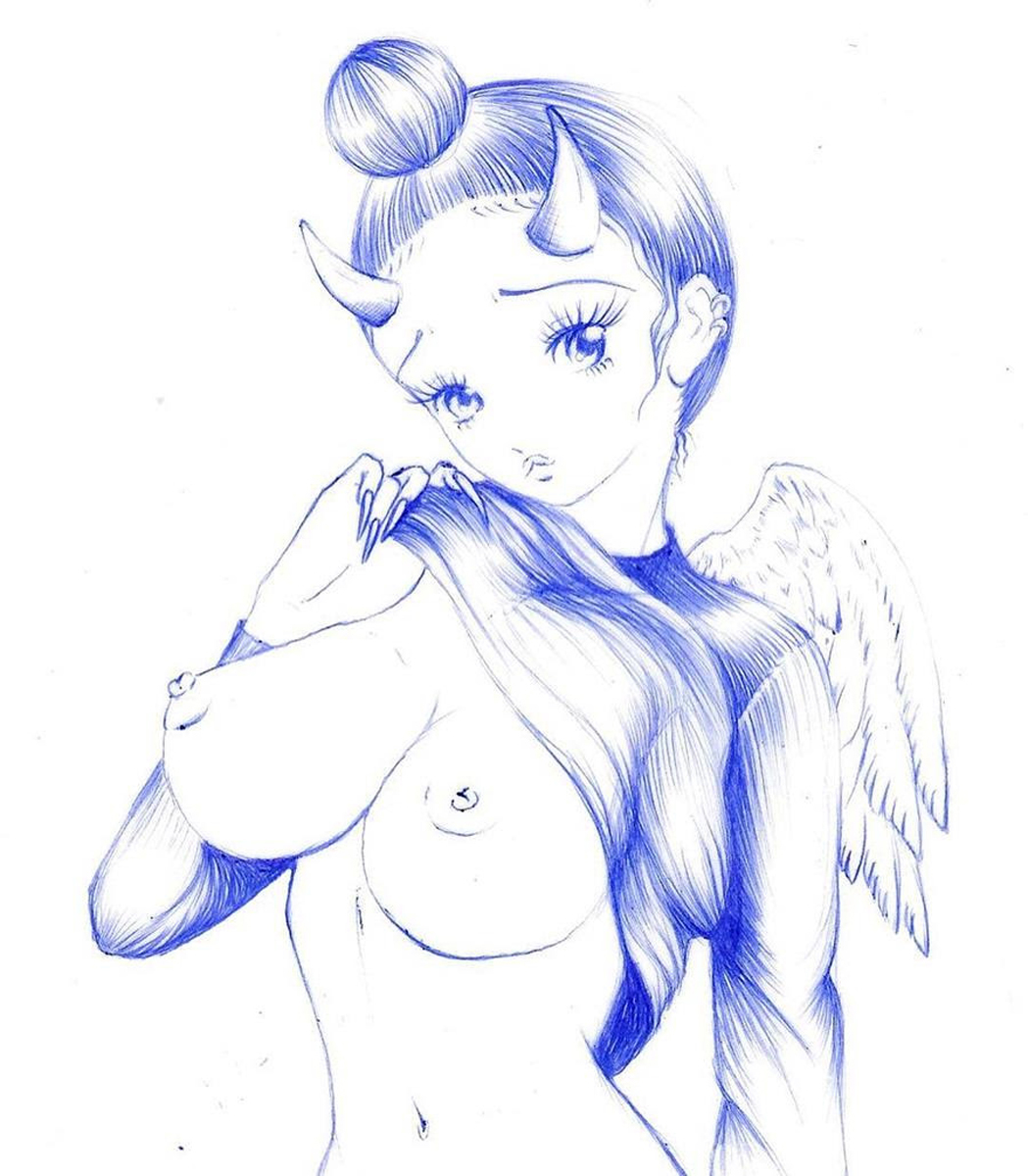
Opening reception: Friday May 25, 6-9 pm
Manuela Soto's work is both viral and permanent, a contradiction fit for an age where female empowerment and self expression is wrapped up in enduring trends and cyclical battles for Instagram-oriented liberation. From flip phones and fishnets to knuckles that read "B-A-B-Y", the signifiers found within Soto's anime-inspired tattoos mimic the online trends adopted by their wearers. Sensual postures, bare breasts and scowling grins imply agency, transforming manga-like figures into modern symbols of sexual dominance and self-empowerment.
Soto's drawings and stencils could be seen as ephemera on the road to permanence, but they mark a collaborative effort – a marriage of the virtual and the real. Like the online communities they mirror, Soto's illustrations find inspiration across a multitude of cultures and forms, locating their power within the trend-conscious bodies they emulate. From hard-edge latina gangsters to innocent-looking, tear-strewn girls, Soto's drawings echo both caricatures and tribal forms. If the skin is merely a shell of the soul, etching into it is just like trying on the latest trend – your options might be limited, but that's what makes you part of the gang.
Like barbie, each form is similar in structure and appearance, carrying an air of self-confidence that is amplified by her unique aesthetic. Do you identify with the crybaby in a Louis Vuitton bikini? Or the bad bitch with an AK? Either way it doesn't matter. Like with all simulated identities, it's not who you are on the inside that counts. It's who you want to be.
– Taylore Scarabelli
https://lubov.nyc/manuela-soto
Image: ©Manuela Soto. Courtesy of the artist.
#15 • May 16–May 20, 2018: fake snake in a can at Lubov, 373 Broadway, #207, New York, NY
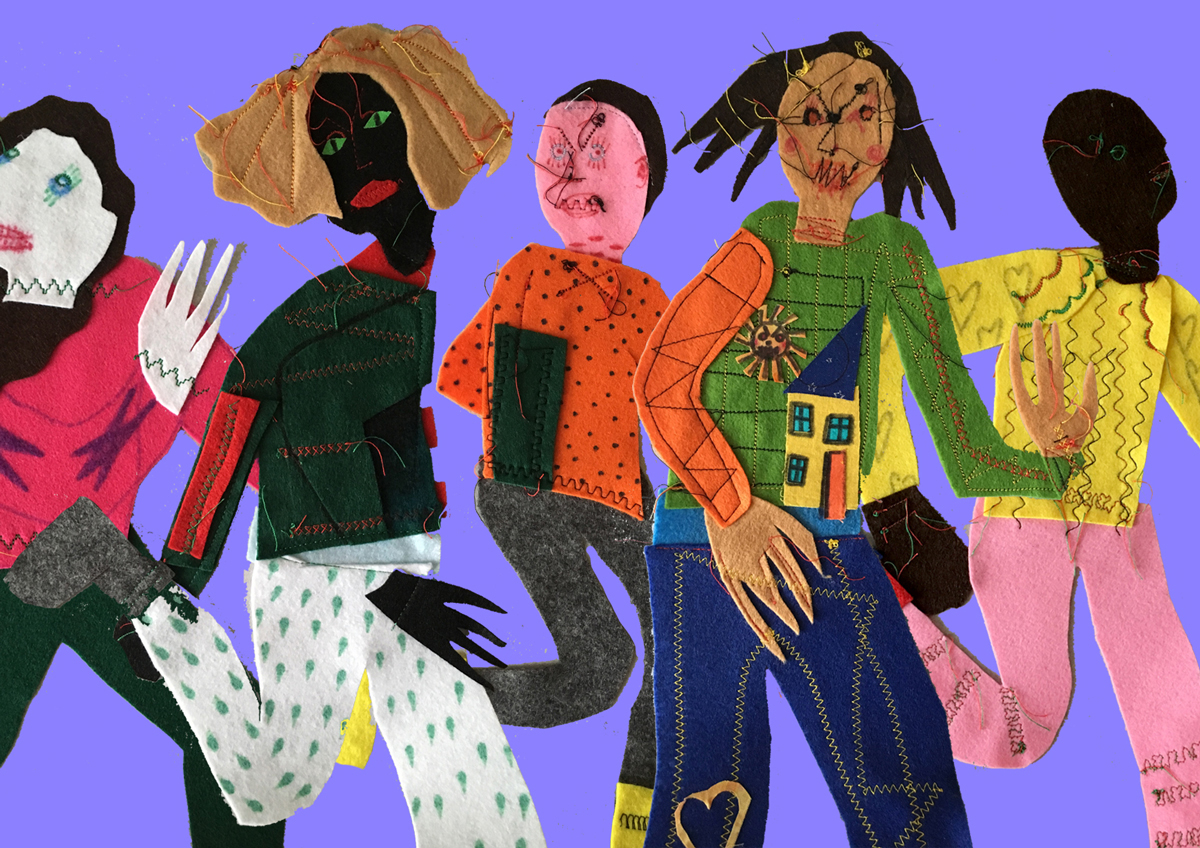
Reception: Wednesday May 16, 6-9 pm
Curated by Megan Uribe.
-
when u lock someone in a cage and they do not know why they are in the cage, they will probably bite ur hand when u feed them
-
running in circles for 12 years would drive anyone fucking berserk
-
lying makes u feel goooooood - dont lie to urself
-
unlearning will take a hellova lot longer than learning
https://lubov.nyc/fake-snake-in-a-can
Image: ©Rita Salt. Courtesy of the artist.
#14 • March 24–May 13, 2018: Parts of Some Quartet, Fruits at Lubov, 373 Broadway, #207, New York, NY

Opening reception: Saturday March 24, 6-9 pm
Jenna Westra uses the body to reimagine The Set as a framework that activates the performers within it, transforming accidental or chance movements into intentional, choreographed actions for the camera. Taking aesthetic cues from performance documentation, her work invites the viewer to re-examine their role and active participation in image consumption.
Relying on the fundamental, immanent traits of analog photography, Westra exploits the formal elements of the medium to create delicate and subtle compositions extracted from the intentional events she creates. A quartet of non professional models and fruit props fill photographs suggesting moments of intimacy and play, while also reminding us of the ongoing negotiation and exchange present in the acts of performing, directing, documenting.
Made in conjunction with the new photographs, Lubov will present a new 16mm film as part of the exhibition. In this alternate format, Westra applies her compositional devices to filmmaking through the introduction of a temporal element, releasing the subjects from the deadpan tone of her still images. This durational component reveals a partial experience of what happens in front of her camera.
The photographs of Parts of Some Quartet, Fruits become a constellation of seemingly separate events, a façade achieved through the use of various lighting techniques and multiple colored backdrops. Meticulous cropping, selecting, and rotating are tools that join a structural narrative together with a loosely held emphasis on the physical traits of photographic media. An anxiety surrounding what it means to both be observed and to be complicit in an an act of observation is pervasive. If pointing a camera is an expression of desire, is it also inherently an act of exercising power? If so, it is our collective responsibility to reclaim the pleasure of looking.
https://lubov.nyc/jenna-westra
Image: ©Jenna Westra, Mariana Sits on "The Complete Photographer, An Encyclopedia of Photography" (1949), Volume 6, Pages 2178-79, 'Best Fashion Study and Best Action Production Still Taken in a Studio', 2018. Archival pigment print. 26 x 21.75 inches. Courtesy of the artist.
#13 • March 14–March 17, 2018: Inset at Lubov, 373 Broadway, #207, New York, NY
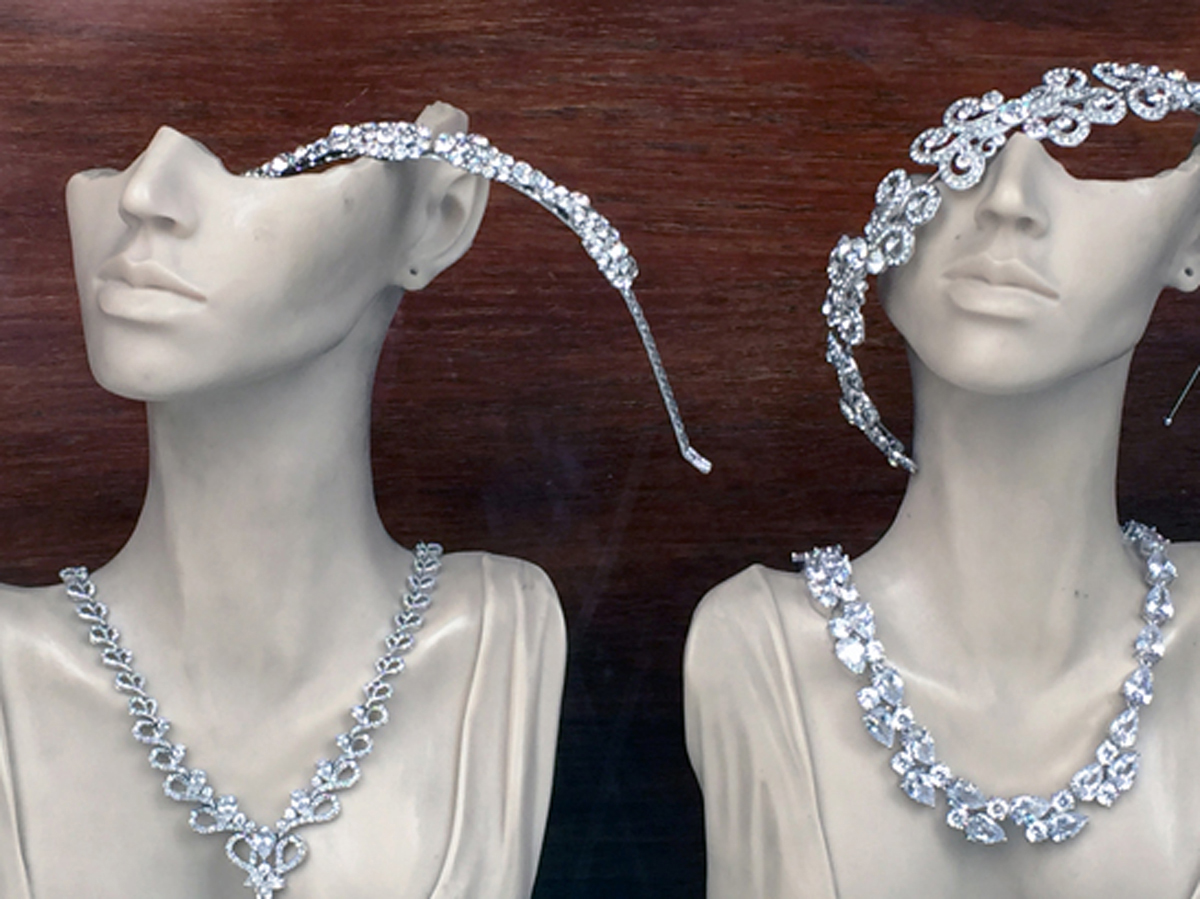
Opening reception: Wednesday March 14, 6-9 pm
Works by Heather Anne Halpert, Ruth Höflich, Anastasia Kolas.
Inset brings together three independent works by Heather Anne Halpert, Ruth Höflich and Anastasia Kolas, each tuning to the malleability of a produced environment. Awareness tracks with a delay, while the senses are ordered, solidified by unseen forces into habits of subtle leveling and filtering, on repeat.
Dyslexia, a condition commonly found amongst artists, is a physical manifestation of doubling, a power and fragility. A dyslexic vision is the result of an unordered flow of visual information to the brain with no dominant eye to sequence the avalanche of perception. The body receives everything at once, simultaneously, overlapped.
Peripheral, embedded, glimpse at a glance: Inset is a lopsided diptych in a room, video wraparound as sculpture dressed up to audition for a play in three parts. The play bill promises a dramatic reenactment of pre-set, side-effect and agency. Roger Caillois describes dissymmetry as the accidental cut or break in an established symmetry. It is by definition transient, a moment of change into something new.
Strung together across two channels, the video works invite the viewers to revisit their daily entanglement within the visual and sensory flow.
Image: ©Anastasia Kolas, midtown wish pearl. Courtesy of the artist.
#12 • January 27–March 11, 2018: Potemkin // Body at Lubov, 373 Broadway, #207, New York, NY
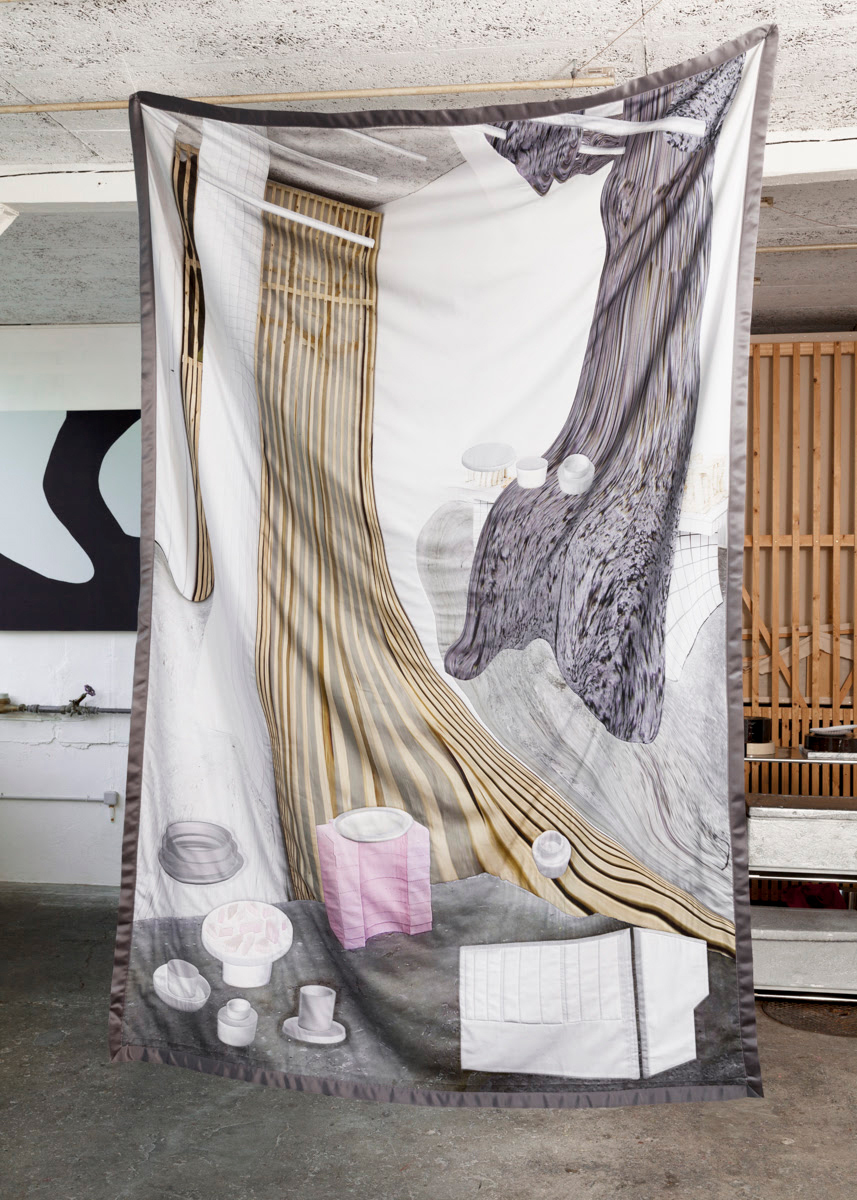
Opening reception: Saturday January 27, 6-9 pm
Works by Ann Greene Kelly, Cécile Krähenbühl, Devin N. Morris, Mario Navarro. Curated by Ramsay Kolber.
Potemkin//Body is both workaround and wall: a framework built from a façade // surface as functioning surrogate.
It is avatar identities, assumed structures of knowing and behavior, illusions of safety/prosperity/space. It is the abstract body in variable forms: political, physical, virtual, and architectural. It is not static, nor whole–rather changeable, material unto itself.
//
Surfacing from the notion of the Potemkin Village, this group exhibition seeks to investigate the ways in which media and medium shift our understanding of personal and social structures, and how they can be (de)constructed.
Working across and between disciplines, the artists included independently interrogate the solidity and definition of accepted frameworks, whether a question of physical environment, personal identity, or societal constraint. They thrive in the fluidity formed between surface strictures and internal substance, actively engaging space as a form of subversion. Seemingly sound while intentionally elusory, these works repeatedly dissolve and reform anew, destabilizing the physical site and body as a source of certainty.
In turn, the truth of the Potemkin Village was an intended lie. A self-reflexive myth in content and construction, it was deception employed towards political capital. Yet whether material or mirage, the structure was built // alternative, meta, resolved // out of nothing–and so it remains.
//
https://lubov.nyc/potemkinbodyl
Image: ©Cécile Krähenbühl, Couverture #1, CÉRAMIQUES, 2016. Cotton, wool. Courtesy of the artist and HIT, Geneva. Photograph by Lucas Olivet.
#11 • December 2–January 14, 2018: A groundbreaking, missed party at Lubov, 373 Broadway, #207, New York, NY
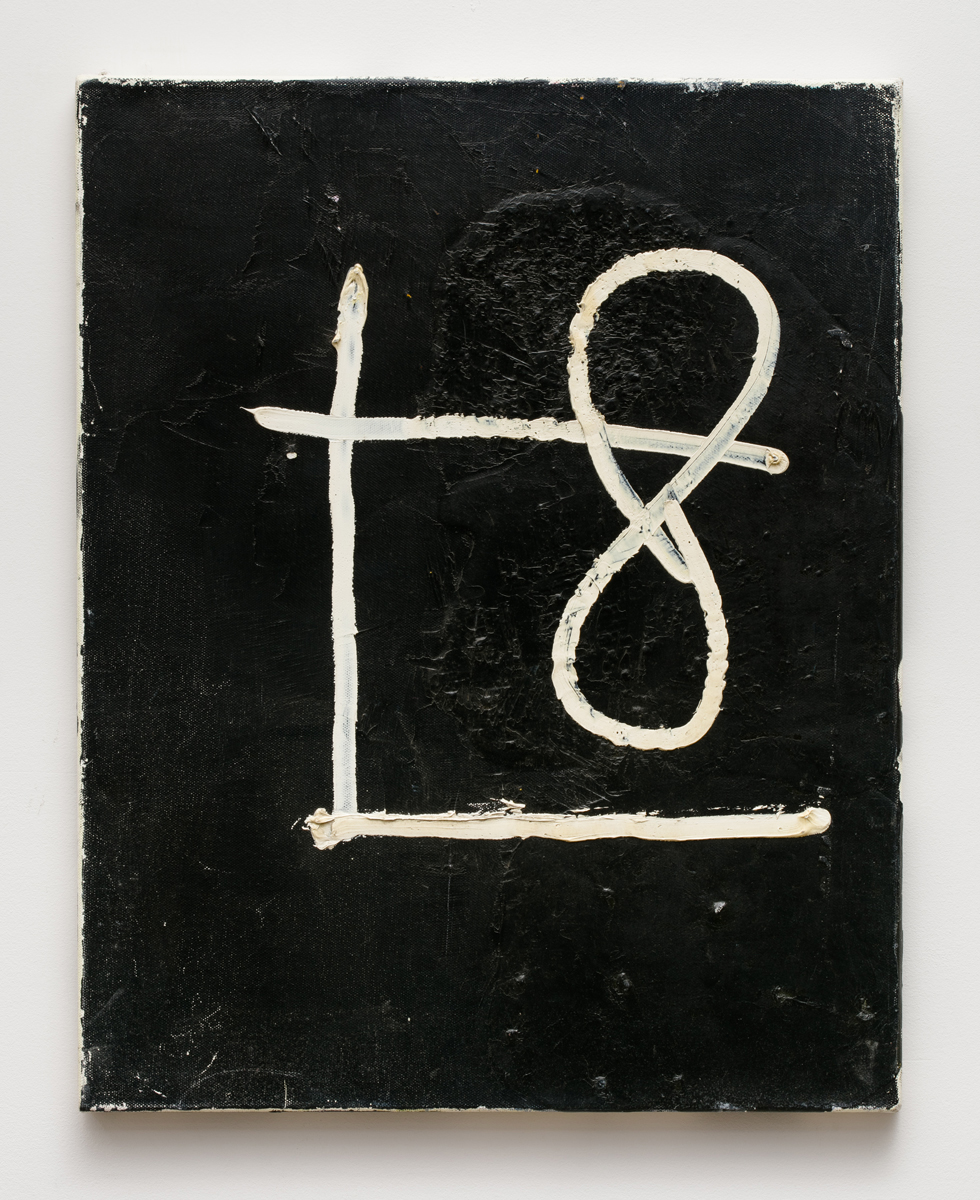
Opening reception: Saturday December 2, 6-9 pm
One cortado please, says Pedro Make it two, I say Cortado is a small coffee in a small very small coffee cup with a drop of milk that cuts the intense brown with the white. Very white.
His cap resting on the table. The table outside. Made of wood. His misty eyes from the morning light that makes them light up because of the sensibility that moves him and touches his lacrimal.
Pedro is vegan. Pedro is vegetarian since he left his parents house. Pedro is vegan since he moved to New York. I am vegetarian though I sometimes eat fish. I am not a vegetarian. I eat fish. When I met Pedro who is vegan I decided not to eat neither red meat anymore nor white meat except for fish. Some days ago Pedro walked by two men on the street. One man said to the other that Pedro seemed to carry with him a child. Inside. When we enter to a hotel we do it through the door, the big one, the one with the sign on top that says entrance or the name of the hotel or something similar. The main one. The main one? Pedro says that what he creates and thinks for this exhibition comes from a juxtaposition of things he has been going through in his life and of an intention of getting into a place through the service door, the back door, the one that employees use, the one that has a sign of private property do not come in authorized personnel only, as a psychic deviation. A shortcut. We are in a time of approximation, of change. Painting is contemplative, says Pedro. This is its difference with what is not painting that is all the rest.
Painting is contemplative, I repeat Art for the sake of art, says him
Sometimes I ask myself what I would like to ask someone else. Catalina: Who are the artists that have influenced your work is the most aggressive question someone can ask somebody, sorry for the rudeness, but what would you reply? Catalina: I would reply something like it's all in the street, out there, nail salons, food establishments. For Pedro it is definitely food that changes him year by year, month by month, minute by minute. The food, to which his body adapts to, the one that makes him go out to the street every day, the one that keeps him on his feet. It is a way of living doing it in the way each one does it.
Things to do: -Look up self-sufficient farms. Build one. See how it is done first. Budget. -Everything is so absolutely controlled. Try to avoid control. Escape for a while. -Accept the error. Human.
For halloween he bought spicy pumpkin seeds. I tell him the spice is not spicy, it's cinnamon. It's with what our grandmothers and mothers used to cook the rice with milk and the natilla. The mist is a steam in the air. Pedro prefers almond milk. Soy milk is too liquidy. Spontaneity is what we need to get out of this closed circuit in which we get trapped: routine trends alienation superficiality plastics packaging and the habits we create, says Pedro. Here today now un-alienate us and feel what he says he feels. What he feels. And just that. Just this. Feel. To be...
Mist.
Maybe it's just a cloud passing by.
Animals have a life cycle. We have a life cycle. Both conclude in death and nevertheless they don't conclude. A party is a celebration. Celebrate we celebrate many things with no sense, others make sense. Sense is a subjective and collective construction. Personal and cultural. Death is celebrated. It is a macabre festivity. Sinister. The movie The Exterminating Angel by Luis Buñuel shows the development of a party into tragedy with a subjacent theme: the impossibility of getting out of a limited space. Finite. Which doesn't have everything that makes life possible. Luxury dematerializes and becomes mundane. The reason is nothing and everything.
Pedro thinks about excessive consumption, the immeasurable slaughter of animals that are not born to be treated as what they are, but as objects. Objectified. Animals are not objects, we are living beings. In Spain 40 million hams are sold per year. While Pedro is saying this to me he drinks a cortado from a small paperboard cup with a big blue P printed in the surface of it and it is blue as his hair. As his eyes. The reflection. The mist is in the eyes of who can see it. In the eyes of Pedro that are blue you can see the reflection of his hair that is blue, maybe his hair is reflected on his eyes maybe his eyes are a reflection of his hair.
Some days ago I went to a party. Then I left the party.
– Catalina Arzani
Image: ©PS3*, Untitled, 2014. Oil on canvas. 20 x 16 inches. Courtesy of the artist.
#10 • October 7–November 19, 2017: If nothing lasts forever, will you be my nothing? at Lubov, 373 Broadway, #207, New York, NY

Opening reception: Saturday October 7, 6-9 pm
Closing reception: Saturday November 18, 6–8pm, with a performance by David Mramor: Gong Journey to She at 7pm
Birth Linnea Vedder's recent paintings depict pregnancy, engaging the longstanding analogy between birth and creative genesis (see, for instance, Courbet's L'Origine du monde). Vedder takes up art's classical themes, engaging layering as both process and historical or conceptual content: gravid bodies are overlaid with semi-sheer floral patterns–signifying growth as well as interior decoration–or ensnared in an grid of broad, dark brushstrokes.
Sex There's a dark femme energy to the paintings–bright and drippy pinks, rich purples. Solid brushstrokes form the loose outlines of a pregnant woman's body as if to forcibly delimit her from an environment that might otherwise merge with or absorb her. This woman–these women, cumulatively, with one appearing in each painting in the show–lounges, kneels, spreads her legs wide, leans with the weight of her fecundity; she looks back over her body with an expression of astonishment. Vulvas are exposed, yet rendered as simplified, abstract forms: entrance, exit, chasm. The works themselves stage a tension between transparency and opacity, abstraction and figuration, with paint that seeps into an absorbent silk surface.
Death As much as they express a sense of awe at the regenerative capacity of life, these paintings brim with the ghost energy of Pompeii, where Vedder spent time while she was seven months pregnant. In My Secret (Smiling Skeleton) (2017), a small cartoonish skeleton crouches beneath the open legs of a nude woman, who looks on in surprise at the death she has just birthed. In Sunny Hours (2017), the torso and legs of another nude woman–swollen belly and nipples glowing reddish-pink–are juxtaposed with an ominous pile of human bones; a sundial in the foreground features the ironic phrase I ONLY COUNT SUNNY HOURS. Which hours are the sunny ones–those of the living, we assume? And who's counting?
– Dana Kopel
https://lubov.nyc/linnea-vedder
Image: ©Linnea Vedder, My Secret (Smiling Skeleton), 2017. Acrylic on silk on linen. 40 x 30 inches. Courtesy of the artist.
#9 • September 29–October 4, 2017: Towards Tenderness at Lubov, 373 Broadway, #207, New York, NY

Opening reception: Friday September 29, 6-9 pm
Towards Tenderness is a new collaboration between Sunny Leerasanthanah and David Lurvey. It begins with an installation of photographs, texts, and objects crafted and collected over the past two months. This work will serve as a jumping off point to an extended encounter with the experience of tenderness. This space offers the collaboration an opportunity to open doors to an audience of people on many different journeys, to serve as a reminder that everyone shares a fundamental need for moments of closeness and care.
https://lubov.nyc/towards-tenderness
Image: ©David Lurvey. Courtesy of the artist.
#8 • August 20–September 24, 2017: Pearls at Lubov, 373 Broadway, #207, New York, NY
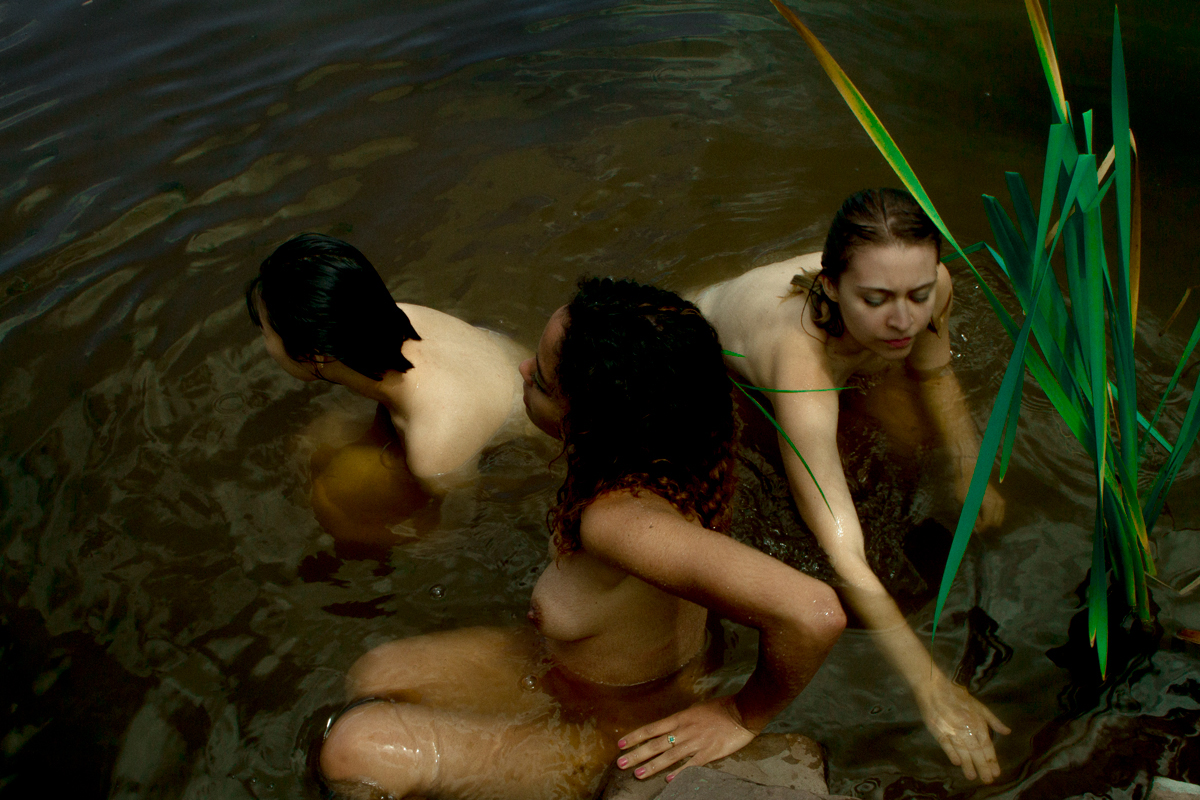
Opening reception: Sunday August 20, 6-9 pm
Works by Maya Bartlett, Grace Hazel, Lula Hyers, Sofiyah McCormack, Grace Milk, Karina Padilla, Natalie Yang. Curated by Natalie Yang.
It was then that the ocean returned to its familiar self and my tears of relief dropped as shining pearls, and pillows of sand welcomed each treasure to the ocean floor as if to confirm that I, at last, was home.
– Natalie Yang
Image: ©Lula Hyers, Untitled, 2015. From the series Sirens.
#7 • July 2–August 13, 2017: Between Tin Men: Gifts and Souvenirs at Lubov, 373 Broadway, #207, New York, NY
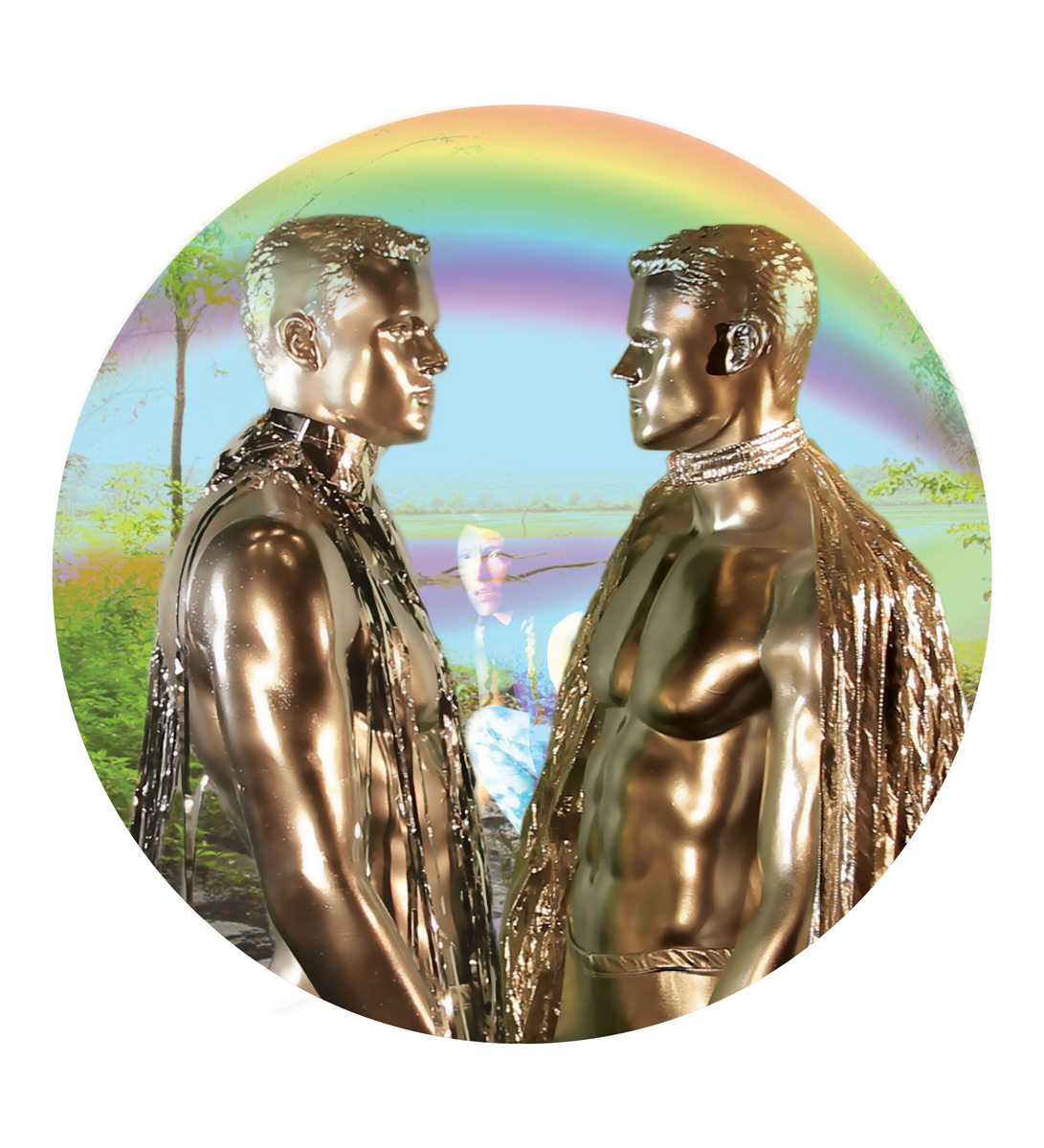
Opening reception: Sunday July 2, 6-9 pm
Occupying the world of L. Frank Baum's The Wonderful Wizard of Oz and its myriad sequels, Amy Ruhl's Between Tin Men reanimates the fairy tale with the narratives of radical feminism, Marxism, and modern love. Manifesting variously as performance, installation, and video, Between Tin Men follows the ongoing story of Nimmie Amee – a minor character in Baum's bewitching universe – and her infatuation with a Tin Man who has already lost his heart to another metal lover.
For this exhibition, Between Tin Men: Gifts and Souvenirs, Ruhl charms life into the various trophies of her adventures through Oz, turning the gallery into a shop that exists in direct opposition to its Disney counterpart. From a magic mirror, the female protagonists of Between Tin Men protest their entrapment in the commercial space of the gallery, violently rebuffing their status as art and as objects of desire. To the side, caught on the smaller stage of the cabinet display, these same faces are frozen in the enamel of collector's plates, packaged for purchase. Arranged like token keepsakes, these characters are made object in a way that both flattens and elucidates the ways in which they were already flat. Despite Jinjur's forcefulness and Polychrome's flamboyance, the reductive materialization of these characters poses subtle questions about the role of consumption in the construction of identity. Fluidly translating Nimmie Amee's devotion to the Tin Man onto the viewer's covetous desire for the objects in the store, Ruhl suggests that, whether sexual or material, desire seeks to fill an absence, to reach for a state of wholeness. Denying us the satisfaction of easy possession, Ruhl presents us with objects already full of personality; these plates are not leather jackets or ostentatious handbags but are fully-fleshed identities with histories of their own. Ruhl invites you to try a type with no promises that its features will slip easily into your own.
– Nicole Kaack
Image: ©Amy Ruhl, Between Tin Men: Gifts and Souvenirs, 2016-2017. Single-channel video, hanging mirror, electronics, display glass vitrine, repurposed antique ceramics. Dimensions variable. Courtesy of the artist.
#6 • May 20–June 25, 2017: Soon enough roads will be rivers at Lubov, 373 Broadway, #207, New York, NY
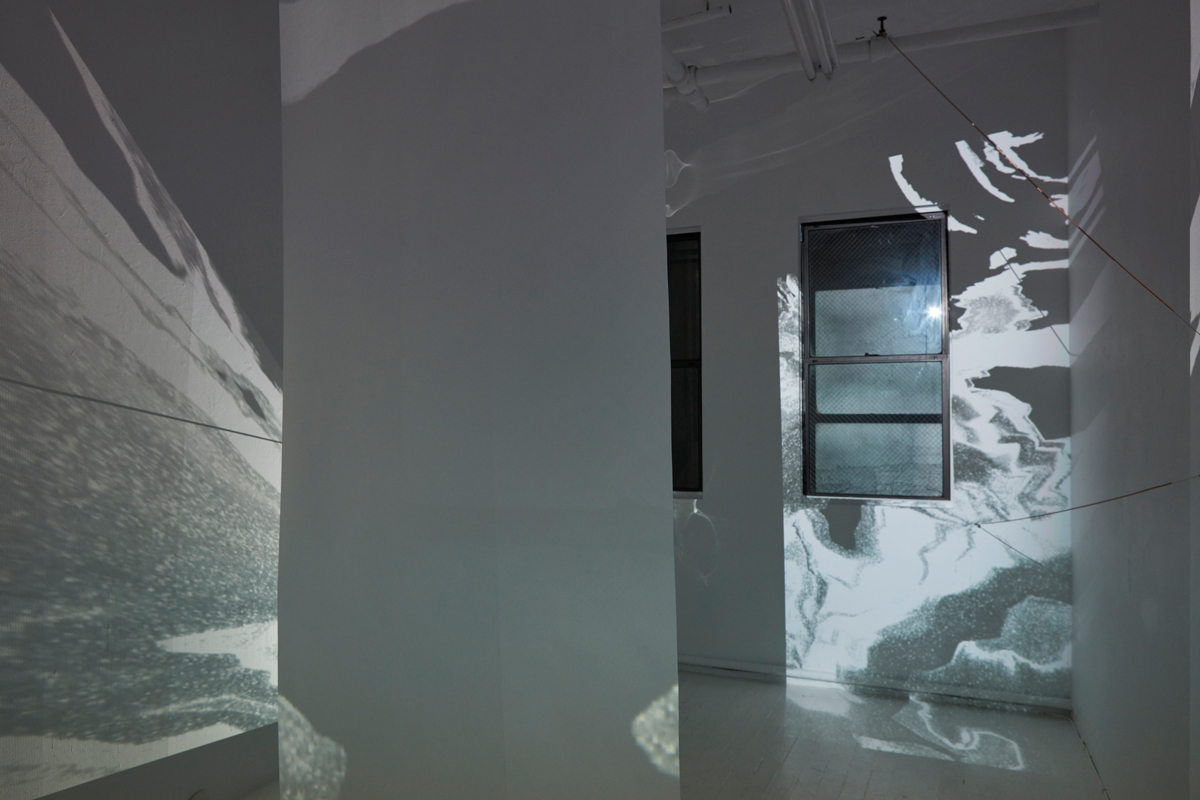
Opening reception: Saturday May 20, 6-9 pm
Luba Drozd illuminates the materiality of projected light. Shimmering ultra-thin planes of transparent acetate, vellum and white paper measure the imperceptible thickness of a room as well as framing the inaudible spatial acoustics within it. A piano string reverberates in a corner while pictorial planes are bounced, refracted and interrupted by our own bodies. Trapezoidal shards of light shift as both figure and ground, inside and outside, articulating flatness and perspectival depth. This slippery perceptual condition is one that reveals itself slowly over time, yet one that resists gestalt cohesion.
Indeed for Luba Drozd, it is the effervescent surface conditions of projected light that encourage a persistence of vision. Unveiling the inherent illusionism of cinematic light, Drozd's surfaces cast shadows of doubt that offer suggestions without conclusions, and narratives without plots. Destabilizing normative uses of one-directional cinematic projection, she mobilizes the viewer through an unfolding array of multiple perspectives6–an immersive tableau where linear filmic sequence is exploded.
Within the field of the projector's throw, she creates an ineffable space somewhere between the real and the virtual, where invisible weapons are momentarily made visible. While animated objects move against the weightlessness of four-dimensional space-time, we are confronted not only by our own shadows but also by the gravity and density of our own bodies. As we move across and rupture this planar loop Drozd seems to remind us–in uncompromising Friedian theatricality–of the transparent systems of surveillance through which our bodies are implicated in daily. A machine for seeing that modifies perception [1], the projector displays, but it also shoots. – Alan Ruiz
- Virilio, Paul, and Patrick Camiller. War and Cinema: The Logistics of Perception. London: Verso, 1984.
Image: ©Luba Drozd, Soon enough roads will be rivers, 2017. 2-channel video, piano strings, custom software, electronics, architectural vellum screens, acetate film screens, 3D printed porcelain. Dimensions variable. Courtesy of the artist.
#5 • March 24–April 30, 2017: Cirrus at Lubov, New York, 373 Broadway, #207, NY
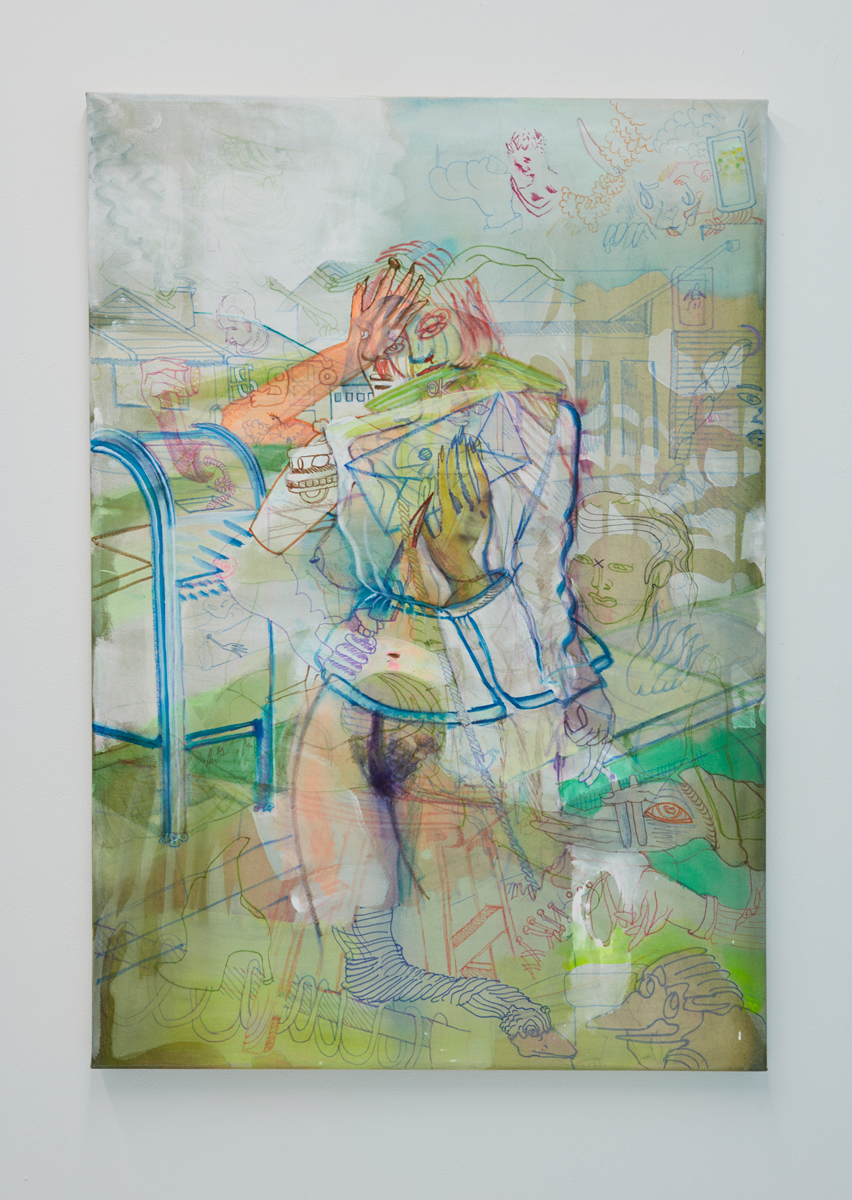
Opening reception: Friday March 24, 6-9 pm
The impressions of the first moments are–recordings to me: of sparkling, trembling pulses; and the recordings–form images; in the imaginings arise–whatever it is; it is imaged; imaginings are–forms. Imagining changes all for me. — Andrei Bely, Kotik Lataev (1922)
Katrina Fimmel's works on canvas shimmer like heat on a horizon. Figures, objects, words, and spatial planes layer to produce a depiction of impossible depth on a supposedly two-dimensional surface. Fimmel compresses space to create the illusion of it.
Fimmel distorts the images she chooses from the never-ending deluge of content flooding the screens we live with. Faces stretch out like they're receding into the distance. Bodies forfeit their solidity and become incomplete circuits open to being penetrated by any nearby word or cloud. Everything floats in the same medium, connected yet discrete, like organisms in water. Fimmel creates images by washing them away. Marks made with watercolor pens are rinsed (in her shower) to the limits of their existence, then the process repeats.
The result is a mutant space in which Fimmel embraces her distrust of images and tricks them into becoming the lies they tell. Information, especially images on the Internet, are not beholden to any static truths. Fimmel both exploits and honors the absurd and infinite possibility of the world we have created for ourselves. — Amelia Rina
https://lubov.nyc/katrina-fimmel
Image: ©Katrina Fimmel, Lime, 2017. Watercolor, marker, gouache, acrylic on canvas. Courtesy of the artist.
#4 • January 22–February 26, 2017: Hard Cry at Lubov, 373 Broadway, #207, New York, NY
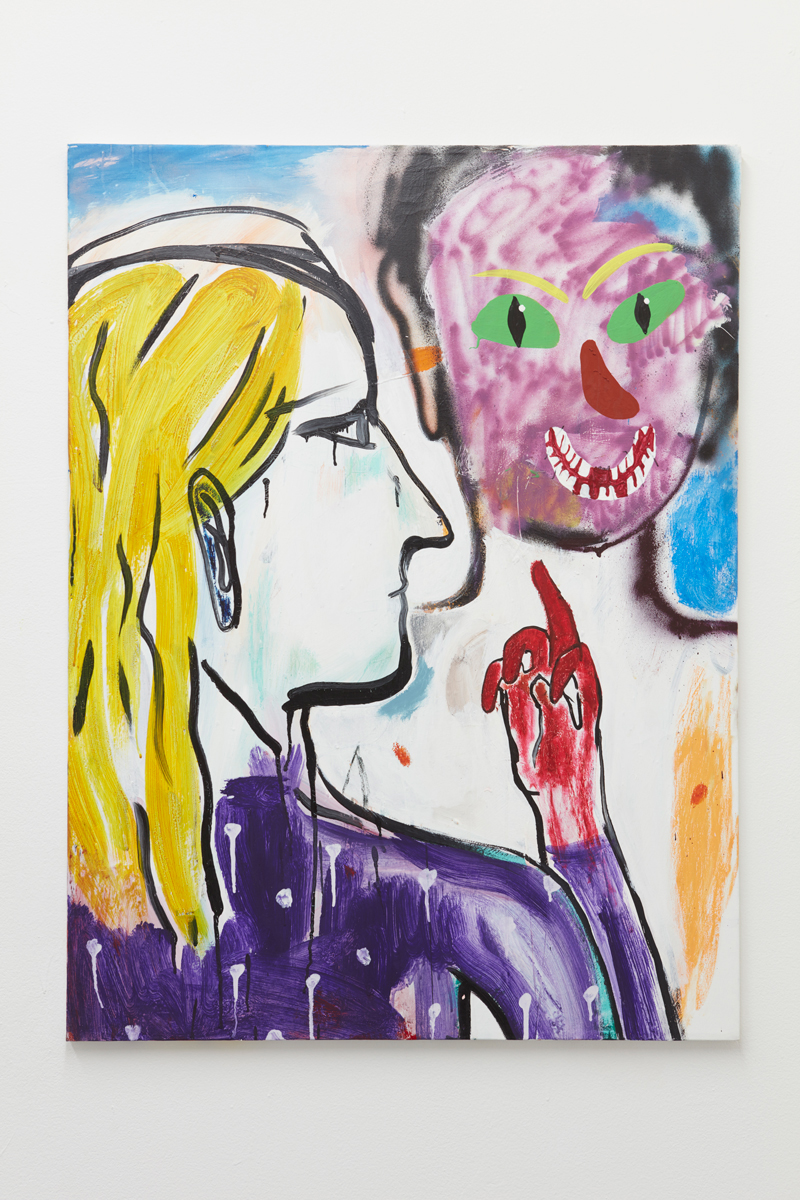
Opening reception: Sunday January 22, 6-9 pm
Curated by Gabriel H. Sanchez
"And perhaps in this is the whole difference; perhaps all the wisdom, and all truth, and all sincerity, are just compressed into that inappreciable moment of time in which we step over the threshold of the invisible." — Joseph Conrad, Heart of Darkness
Lubov is pleased to present Hard Cry, curated by Gabriel H. Sanchez, which brings together a group of five NYC-based artists – Ian Swanson, Cristina de Miguel, Tariku Shiferaw, Ryan Oskin, and Kyle Haddad Welch – whose works of painting, photography, and installation, revel in the emotional sludge of contemporary living to create deeply psychological gestures of anxiety and fatigue. Hard Cry responds to the exhaustive stimuli we experience each day and highlights progressive strides in art among New York City artists, bridging the gap between what is internalized and what is visible.
It goes without saying that anxiety permeates throughout every aspect of contemporary life – in the choices we make and lives we lead both digitally and IRL, amid the company of megalomaniac politicians and nationalist bigotry, the continuous onslaught of new and obsolete technologies, and most profoundly, amid our social networks of friends, family, and strangers. More than ever, art's inherent ability for cathartic release finds itself vital to the well being, perhaps even sanity, of social order.
Image: ©Cristina de Miguel, Middle Finger Salute, 2016. Acrylic, flashe, spray paint and oil pastel on canvas. Courtesy of the artist.
#3 • November 12, 2016–January 8, 2017: Boris Ostrerov at Lubov, 373 Broadway, #207, New York, NY
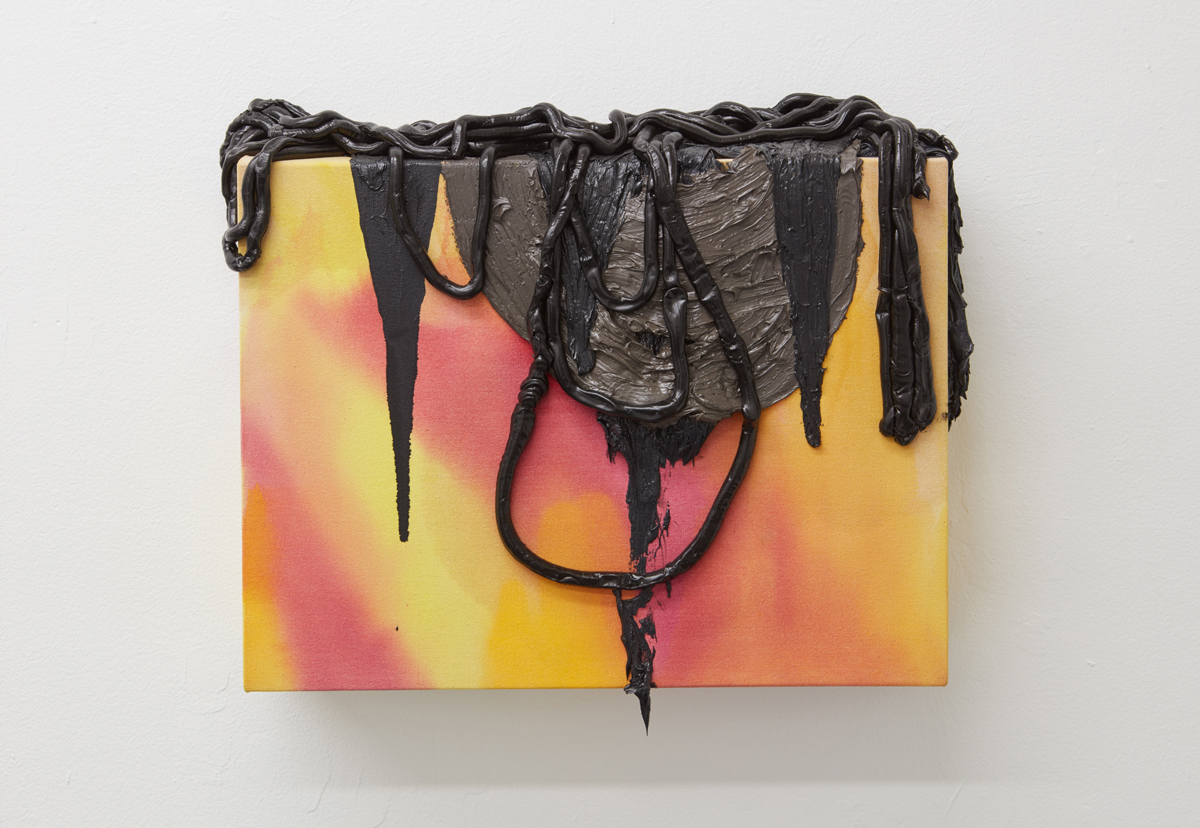
November 12, 2016 - January 8, 2017: Boris Ostrerov at Lubov, 373 Broadway, #207, New York, NY
Opening reception: Saturday November 12, 6-9 pm
For its inauguration, Lubov is pleased to present the first solo exhibition in New York of Chicago-based artist Boris Ostrerov. Rooted in abstract expressionist painting, and utilizing copious amounts of oil paint applied by squeezing it through cake-decorating bags, the works become expressions of libidinal energy, ornamentation and excessive production. The pieces in the exhibition simultaneously function as sculptural objects and paintings, investigating the physical and illusionistic potential of painting. They acquire a robust, visceral and grotesque presence; with moments where the paint's physicality succumbs to the force of gravity. Ostrerov's work mirrors our culture's obsession with indulgence, accumulation and pleasure, and unapologetically celebrates the possibilities that emerge from it.
https://lubov.nyc/boris-ostrerov
Image: ©Boris Ostrerov, Untitled, 2016. Oil on canvas on panel. 17 x 21 x 7 inches. Courtesy of the artist.
#2 • August 24, 2016: Nonspace at Recess, 41 Grand St, New York, NY
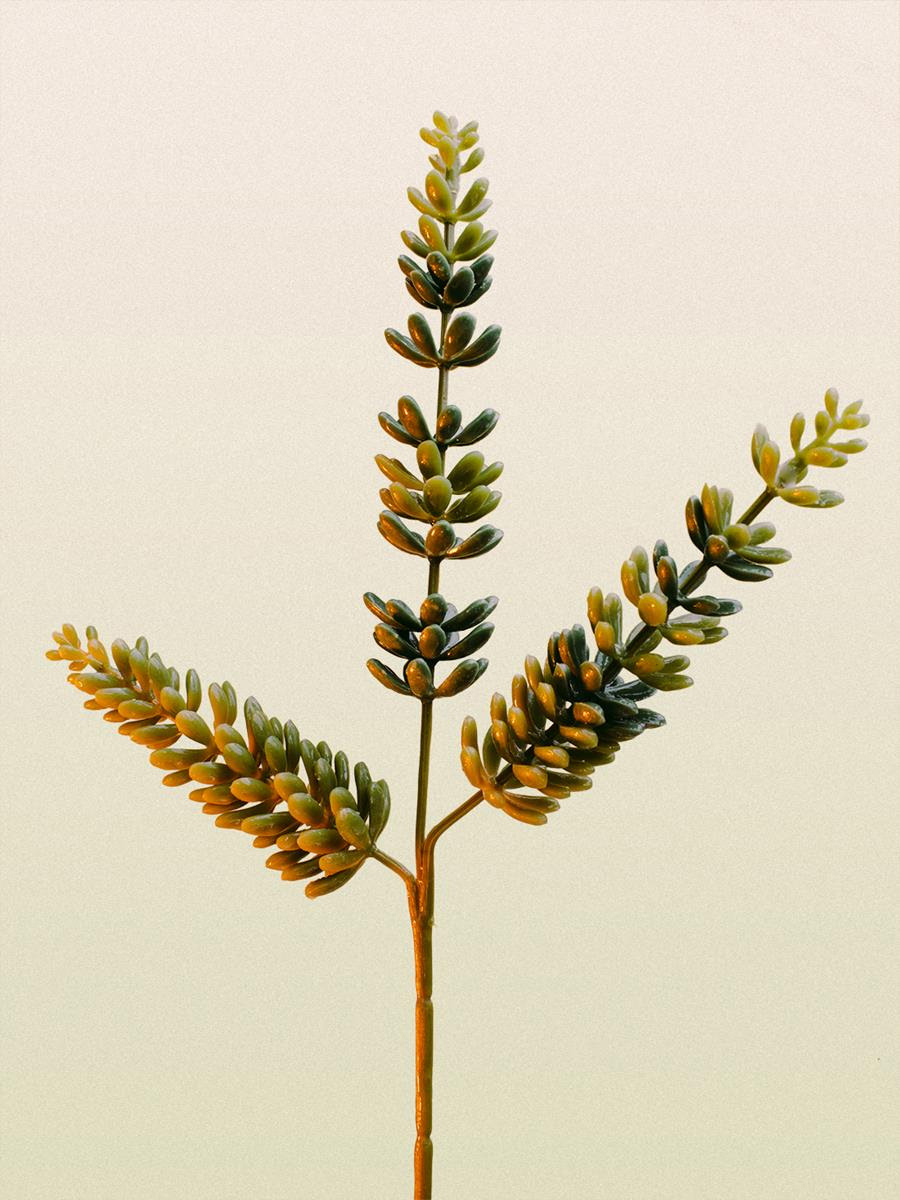
Reception: Wednesday August 24, 6-9 pm
Curated and organized by Gabriel H. Sanchez and Francisco Correa Cordero
"Cyberspace. A consensual hallucination experienced daily by billions of legitimate operators, in every nation, by children being taught mathematical concepts... A graphic representation of data abstracted from the banks of every computer in the human system. Unthinkable complexity. Lines of light ranged in the nonspace of the mind, clusters and constellations of data." — William Gibson, Neuromancer.
In 1984, William Gibson's seminal work of science fiction, Neuromancer, illustrated a neon reality in which cyberspace mirrors the tangible world; a place where e-commerce is as physically accessible as a bodega, fashions arrive and fizzle in the blink of eye, and digital information is supreme currency. The novel, written more than half a decade before English scientist Tim Berners-Lee invented the World Wide Web, stands as a prophetic echo of today's Internet users and the graphic window of data that they experience the world each day.
Nonspace, curated by Francisco Correa Cordero and Gabriel H. Sanchez, brings together seven artists — Daniel Gordon, Dina Kelberman, Craig Callison, Zoe Burnett, Ryan Duffin, Qiren Hu and A. Bill Miller — whose work fringes on that of science fiction. Experiments in 3D rendering, virtual reality, and data manipulation are firmly positioned between lowbrow and high-tech, molding socialweb vernacular into expressions of anxiety, disenchantment and divination. Comparable to Gibson's anticipation of the socialweb, each artist here embraces the digital nonspace for its expressive value in anticipation of what comes next.
http://www.franfranfran.com/nonspace.html
Image: ©Ryan Duffin, Figure_Fuel, 2016. Archival pigment print with laser engraved acrylic. Courtesy of the artist.
#1 • October 17 - November 15, 2015: Double Vision at Silver Projects, 796 Broadway, 3rd fl, Brooklyn, NY
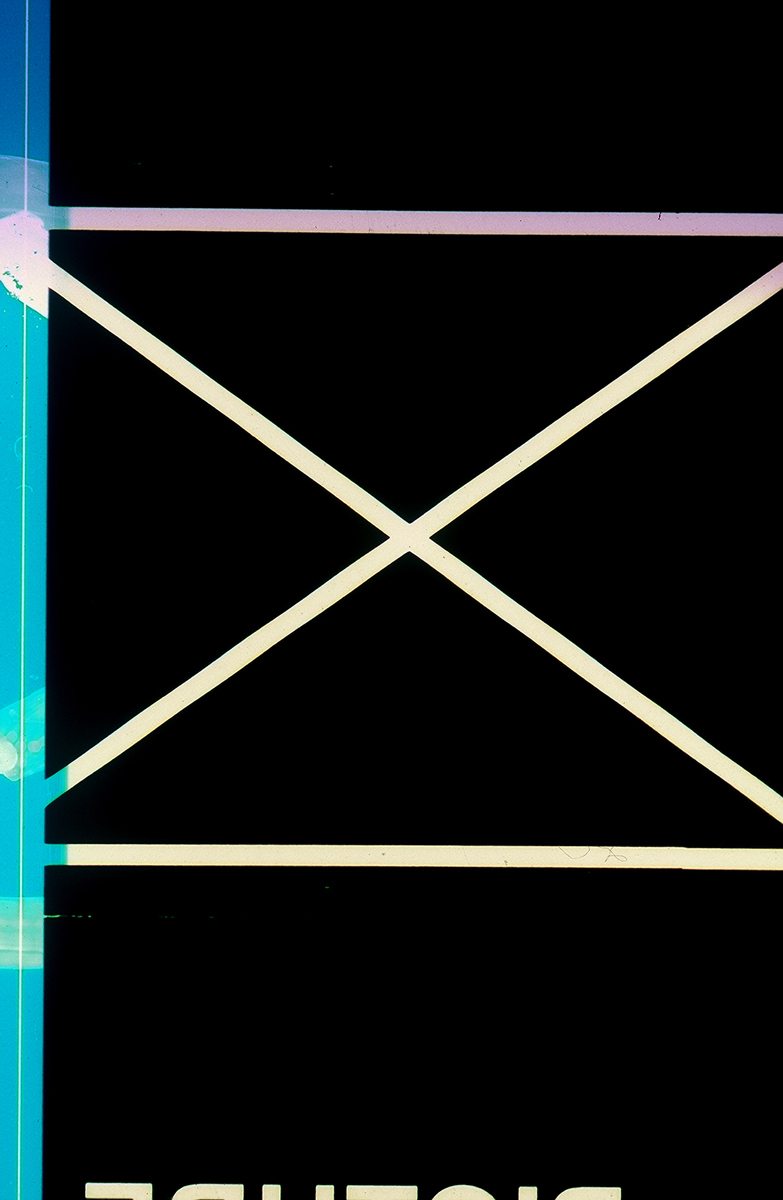
Opening reception: Saturday October 17, 7-9 pm
Organized by Francisco Correa Cordero and James Reeder
Silver Projects is pleased to present Double Vision, an exhibition featuring new work by Eric Cahan, Elizabeth McAlpine, and Liz Nielsen with Carolina Wheat.
For Double Vision, the organizers asked three artists who constantly challenge the photographic medium and its materials, to create work specifically for the slide projector. Taking advantage of the sound, visual and quasi-filmic qualities of the device, as well as its potential for narrative, each presents their work using an entire carousel of 80 slides which repeats itself after each cycle.
The exhibition examines the mechanical peculiarities of pre-cinematic devices without reveling in nostalgia. The slide projector, once commonly found in households and academic institutions; and image projections, a display method that predates any photographic process and that constantly endures through time with its prevalence in new media, installation and performance art because of its ability to transform space. The end result are three independent experiments on sequence, light in space and light on film.
http://www.silverprojects.org/double.html
Image: ©Elizabeth McAlpine, Prelude (found scores) (detail), 2015. 80 35mm slides, found 35mm moving image footage. Courtesy of the artist, Laura Bartlett Gallery, London/Laurel Gitlen, New York.